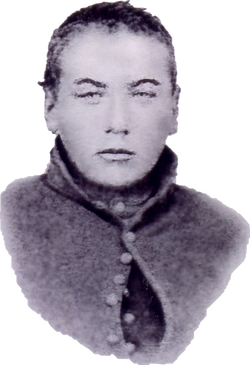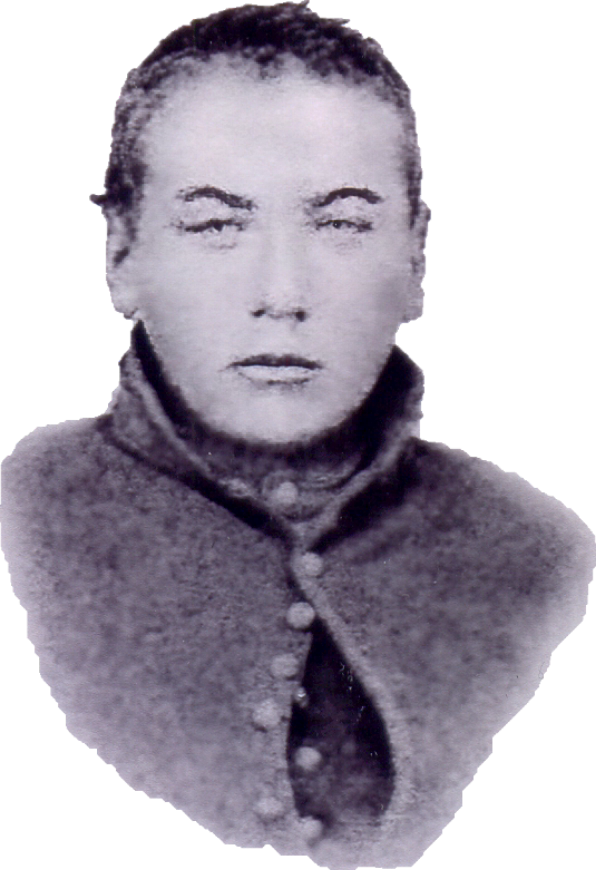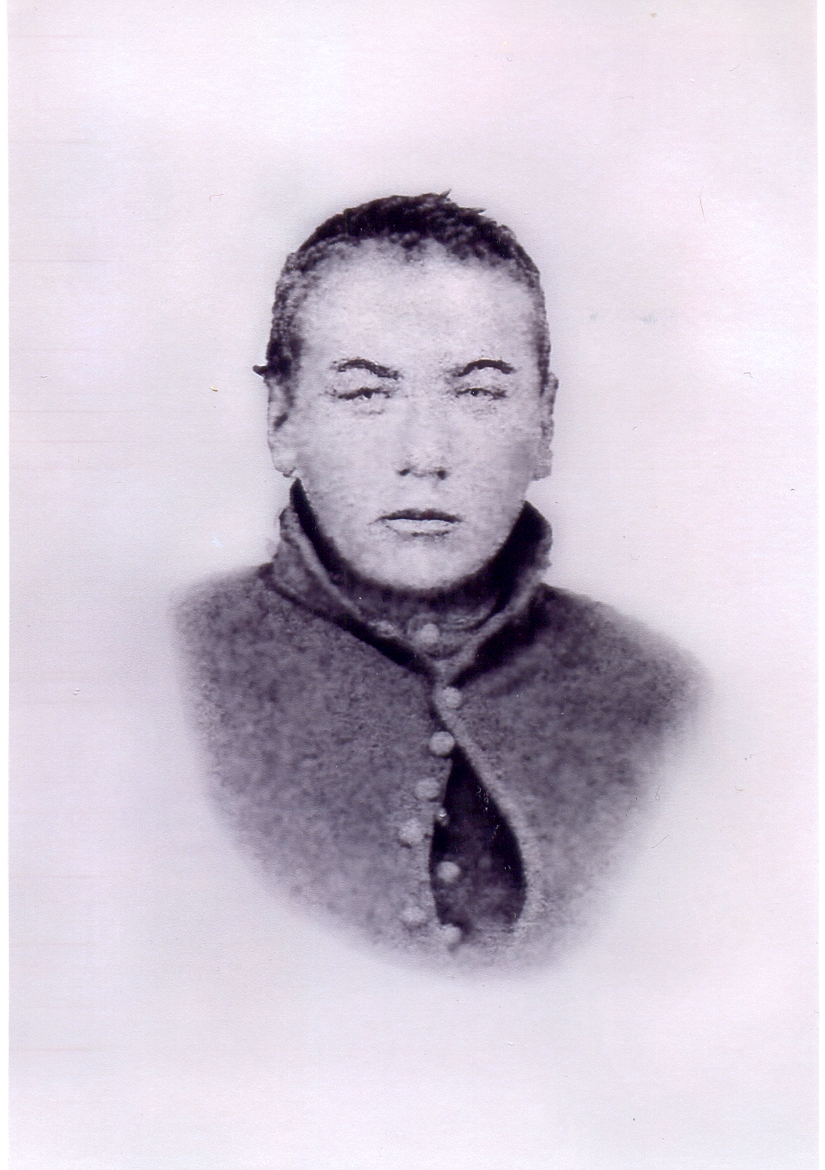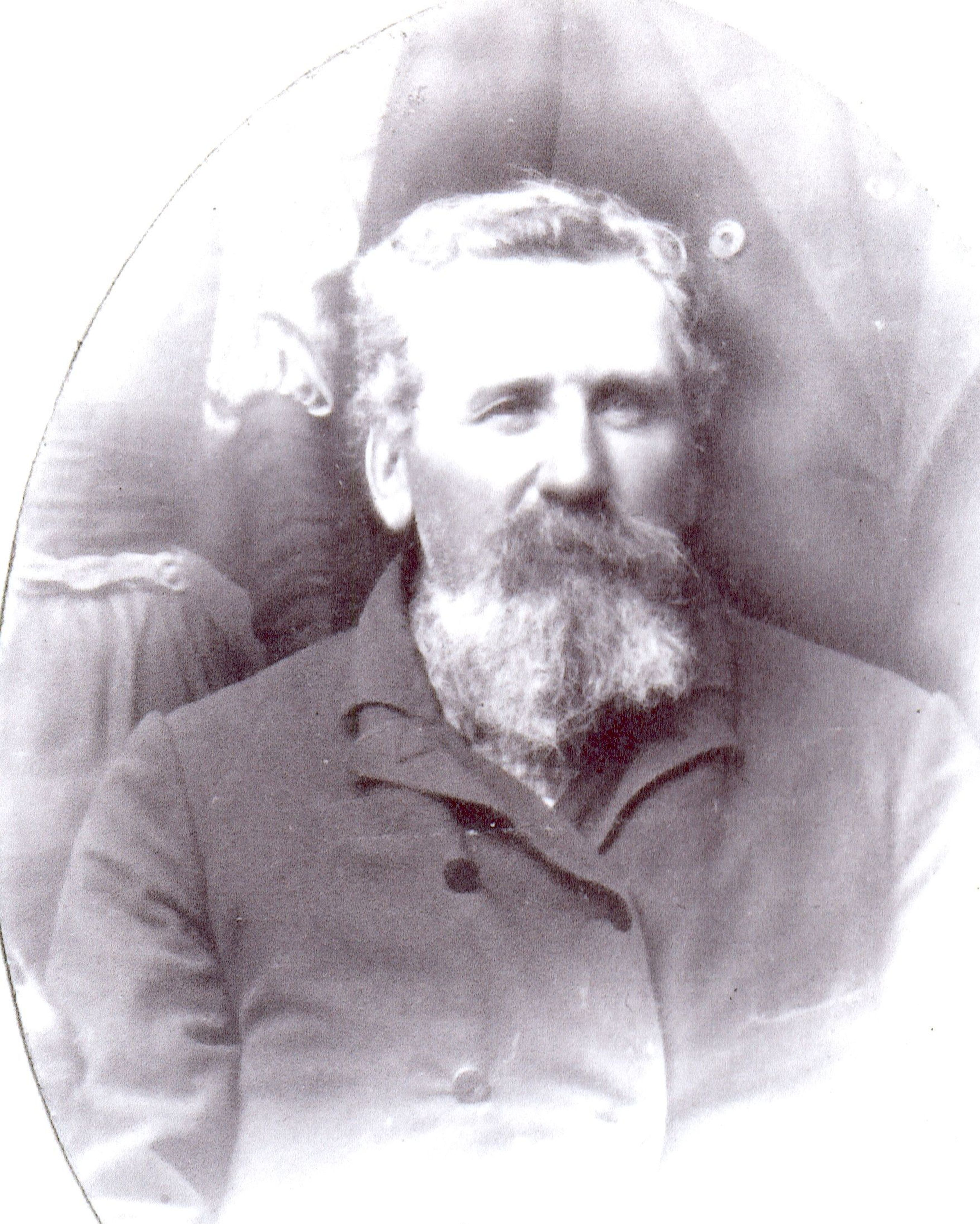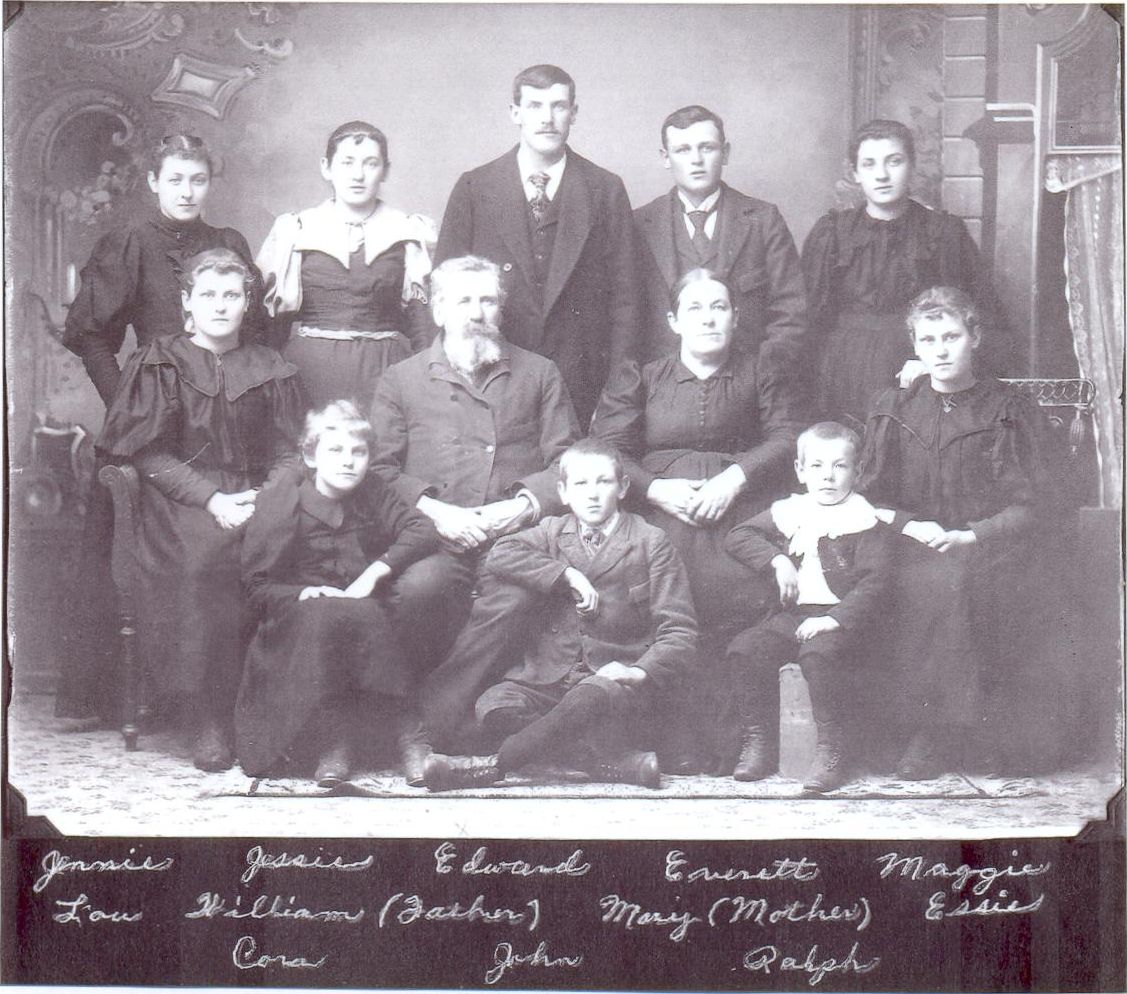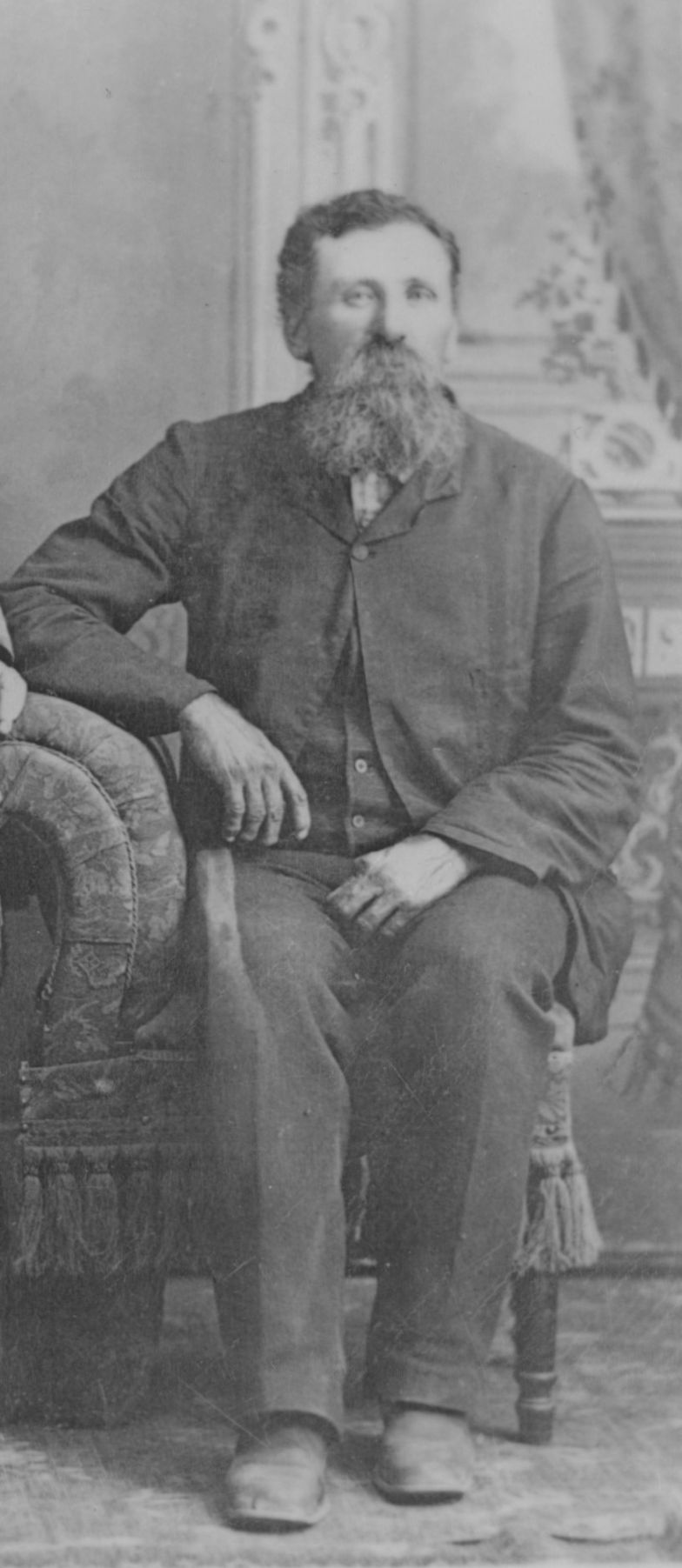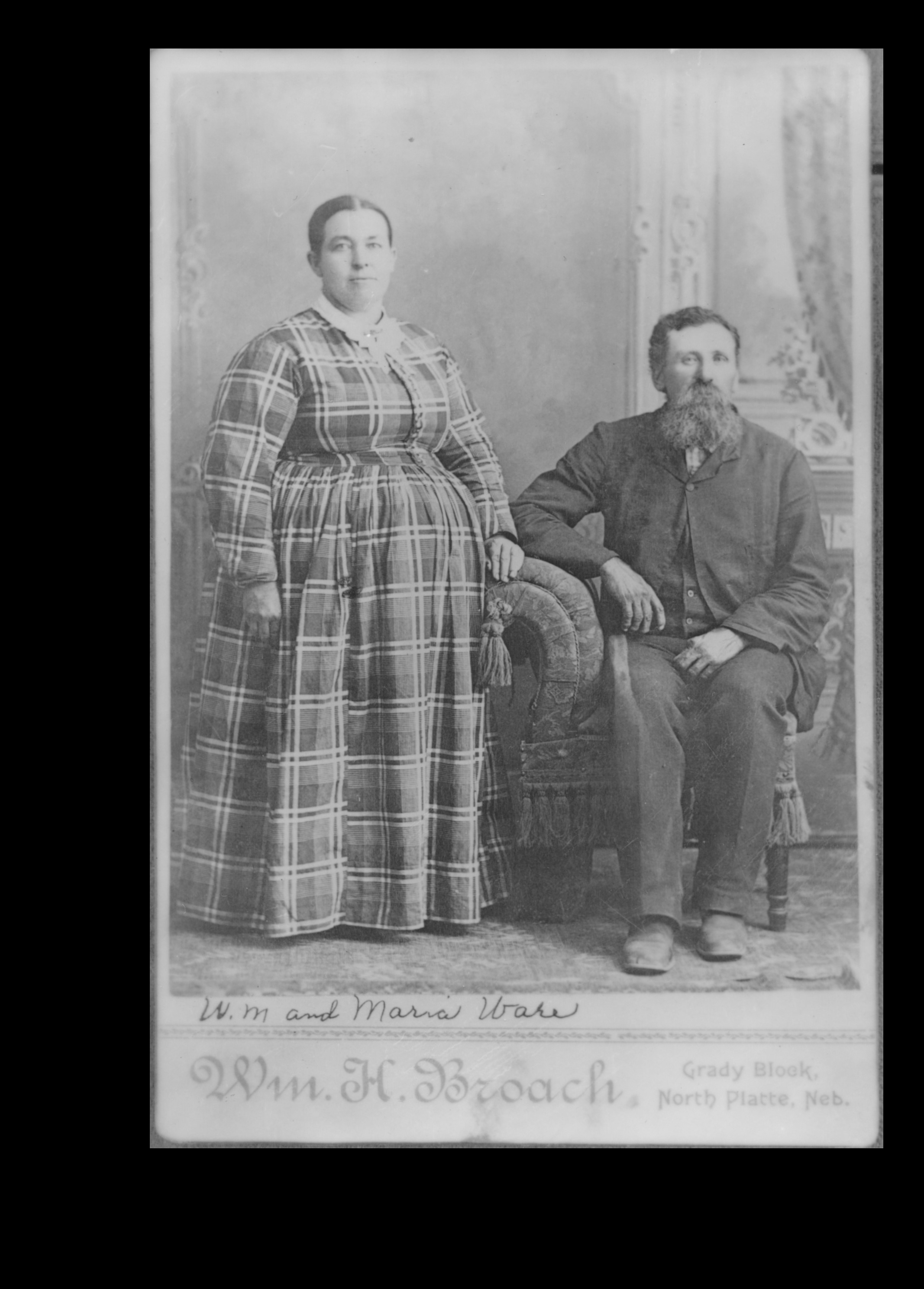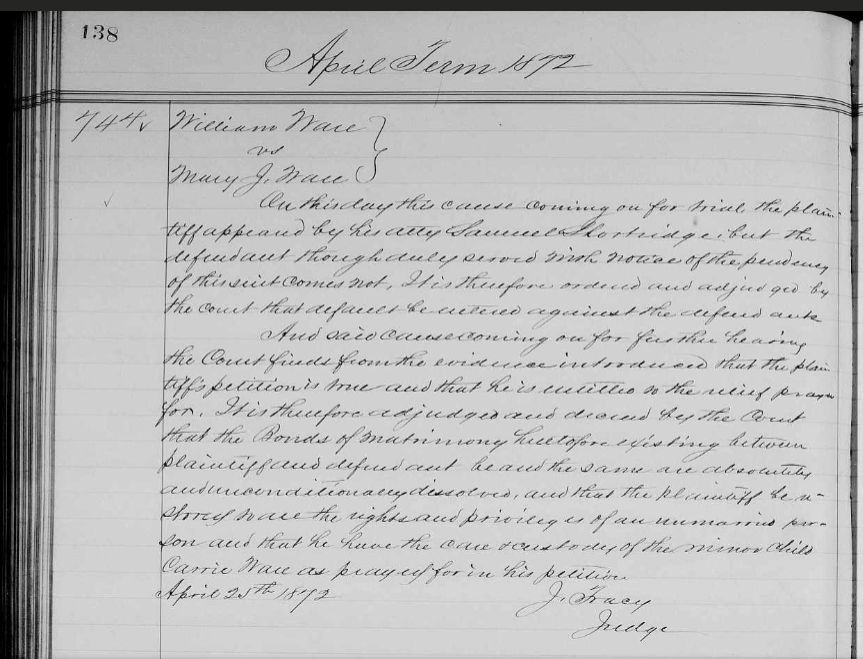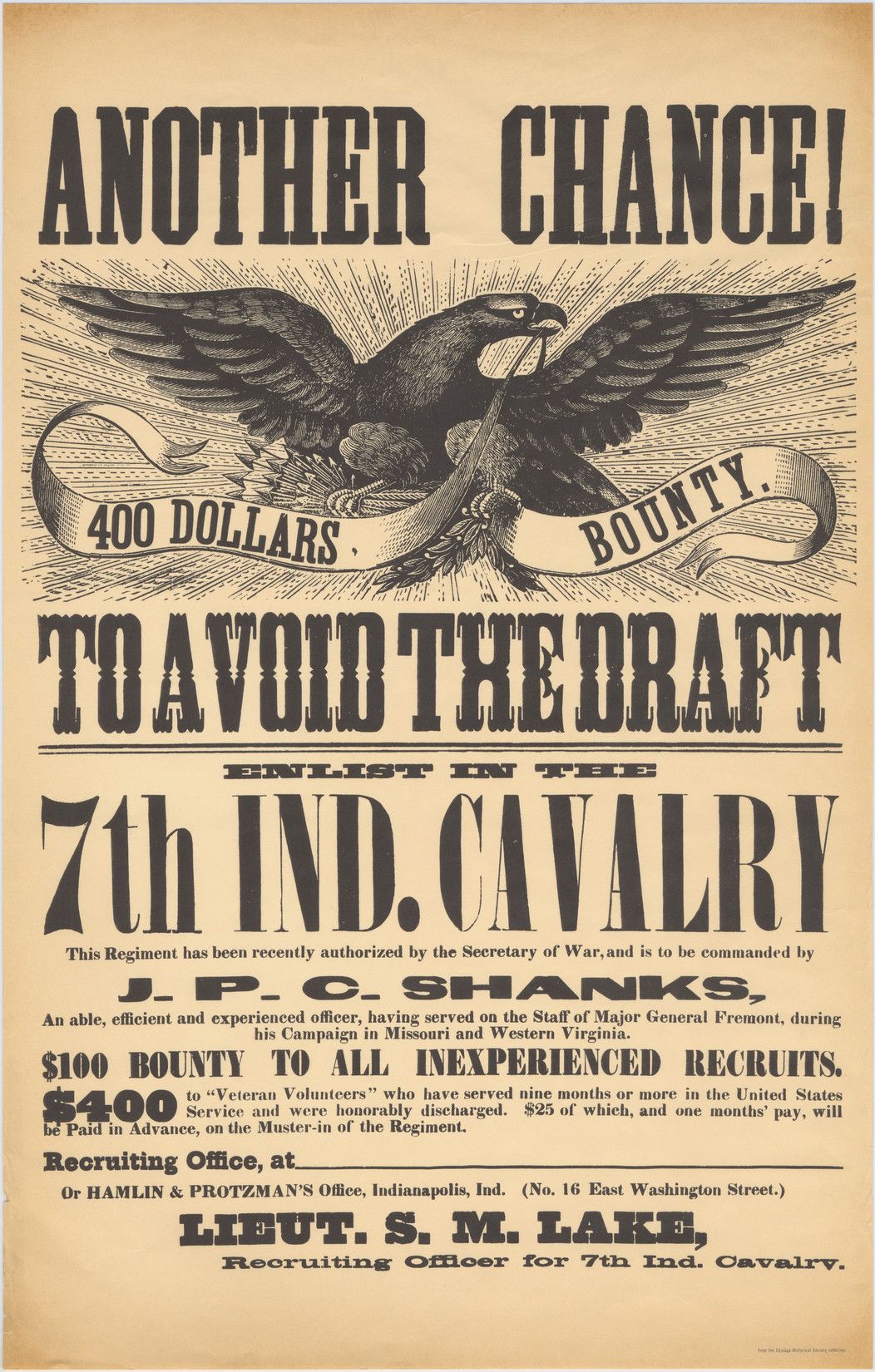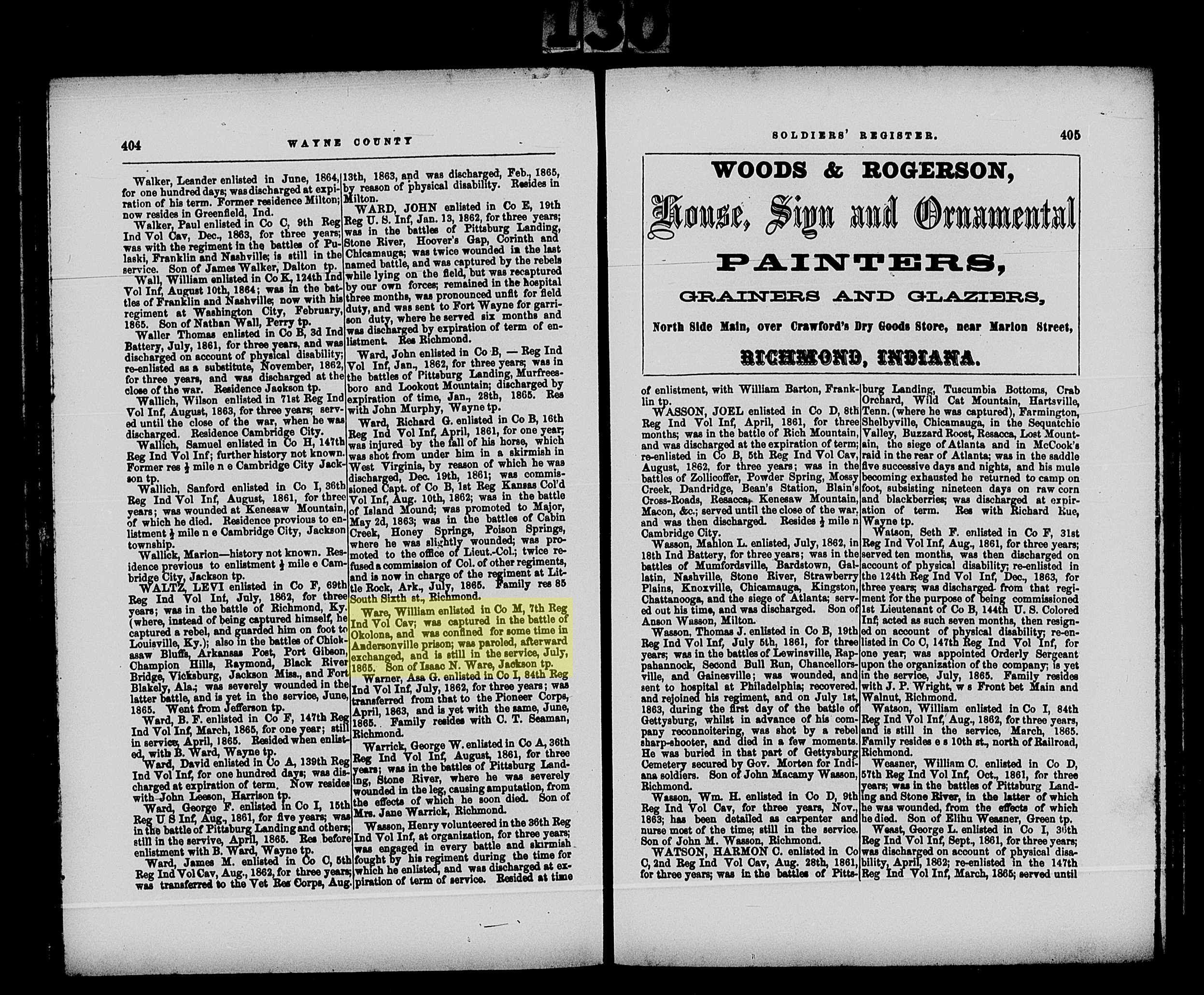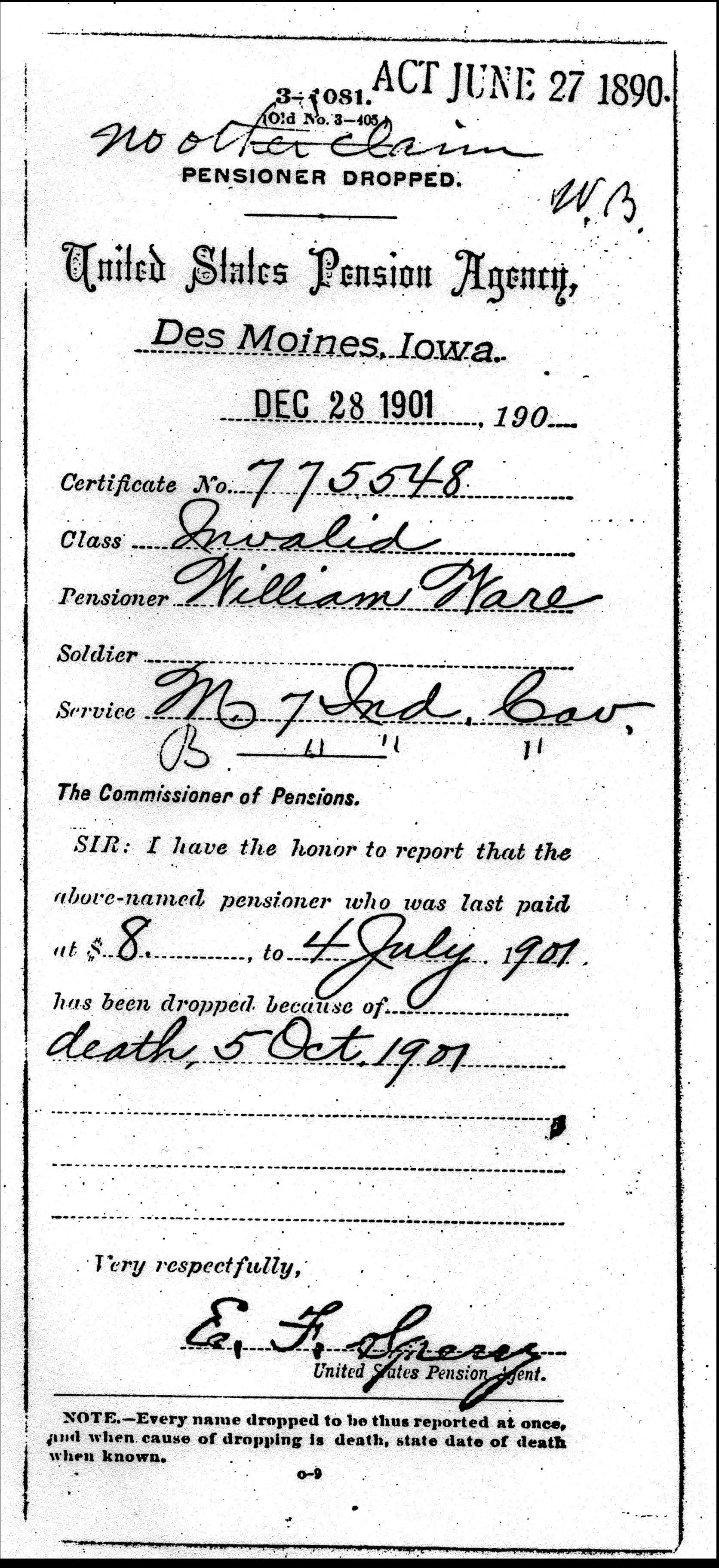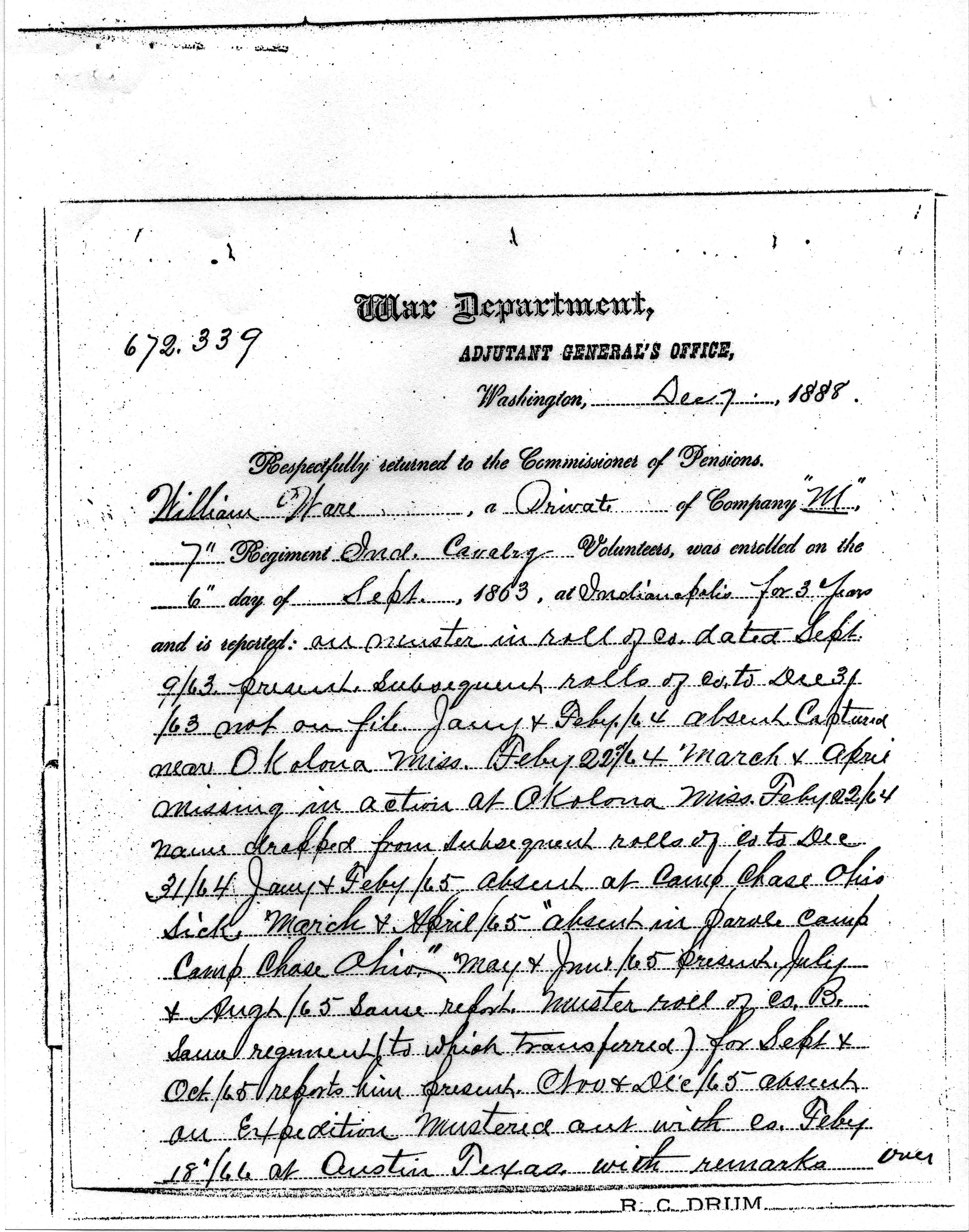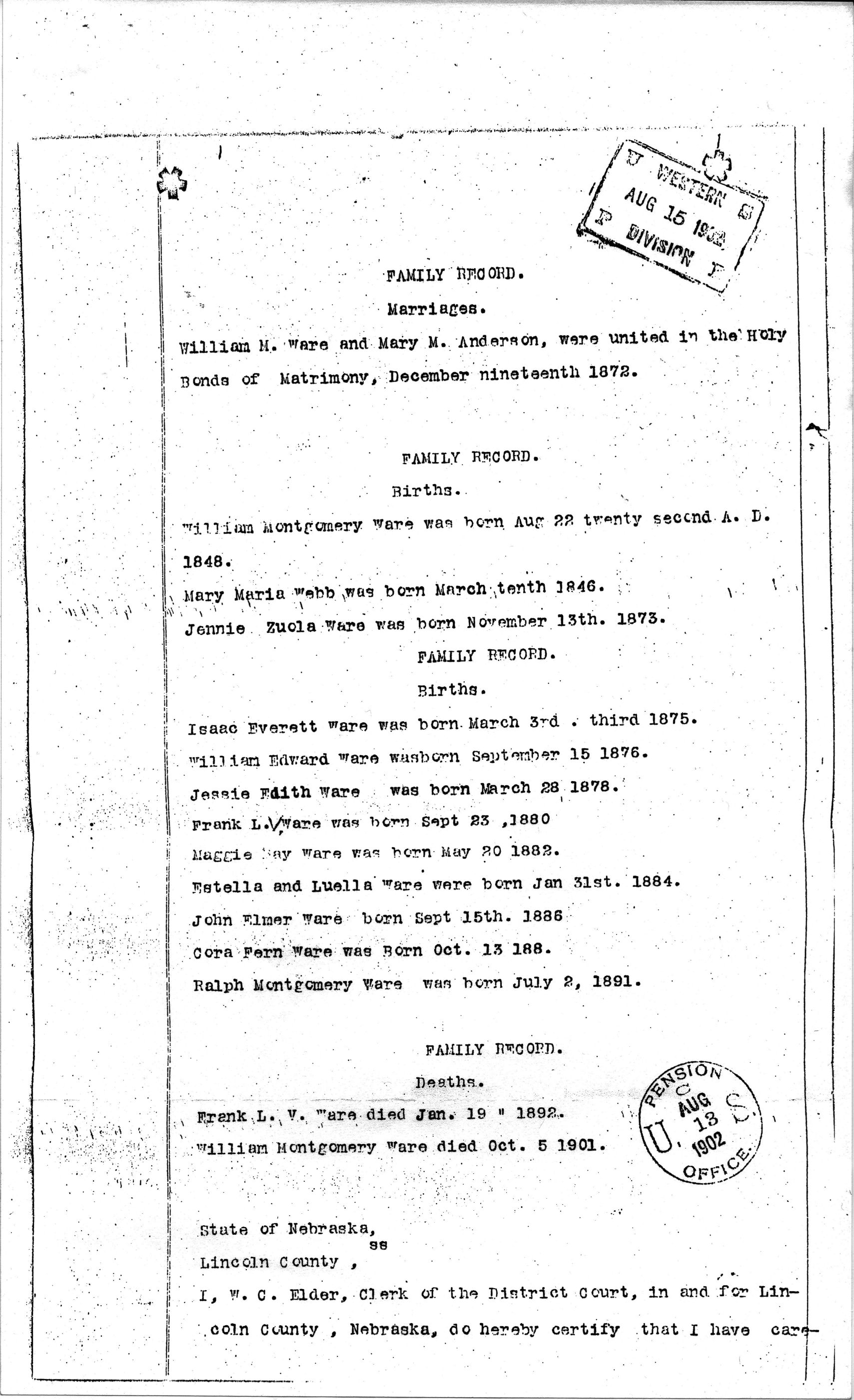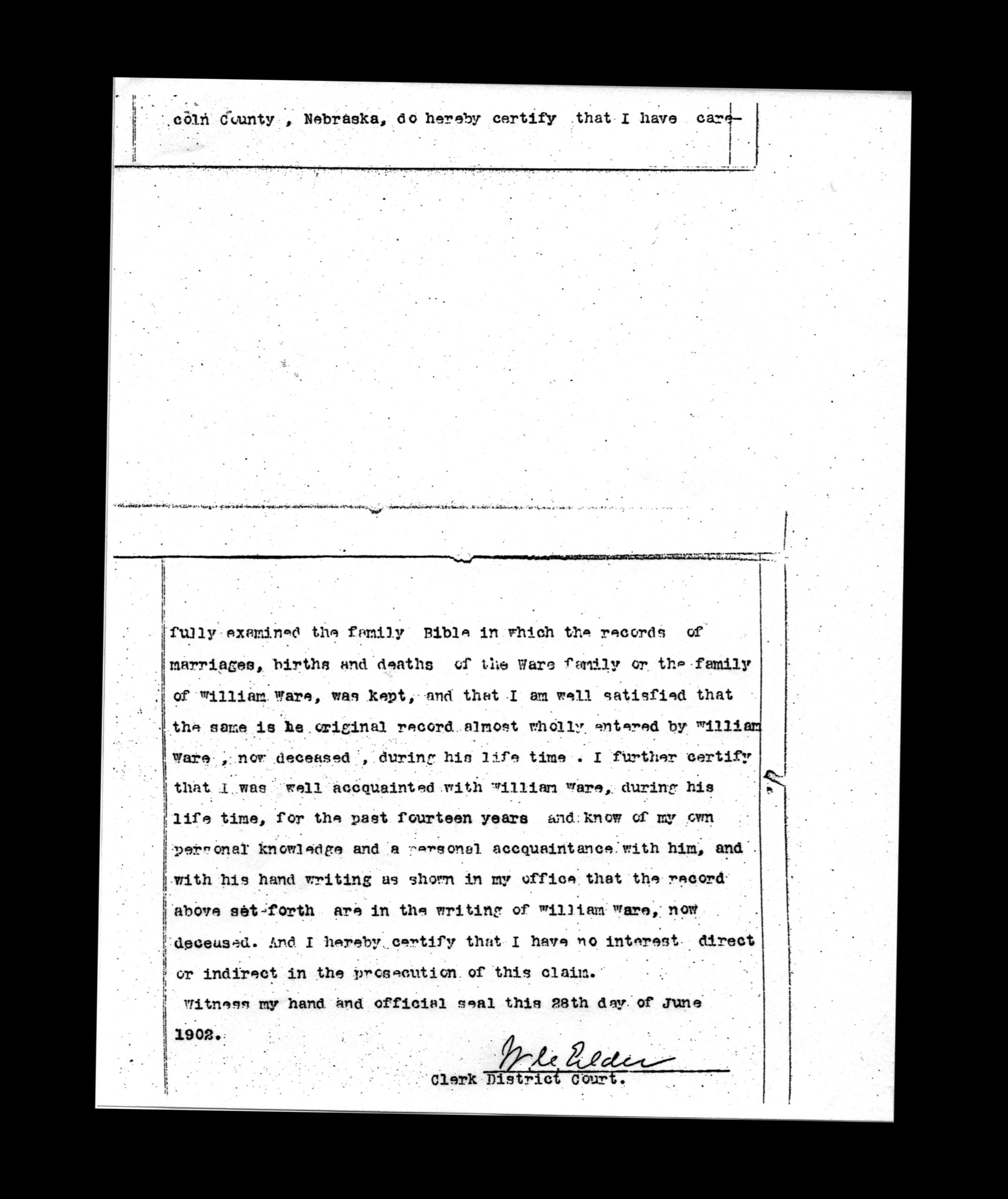WILLIAM MONTGOMERY WARE
___
William Ware
Aug 22,1848-Oct 5,1901
Wm. Ware an old pioneer of this county and who has been seriously ill for some time died of a complication of diseases at his home west of Hershey on Saturday last at nine o'clock, The funeral was held at the M.E.. church in Hershey the following day at two o'clock, which was attended by a large concourse of sorrowing neighbors and friends. The interment took place at the O'Fallons cemetery, he was a man who had boats of friends who deeply regret his demise. He was an old veteran of the rebellion and spent nine months of the time in Andersonville prison and was never a healthy man after that- He was always first in church affairs as well as in the G.A.R.- A wife,several sons and daughters survive him all of whom have the sympathy of numerous friends in the valley.
--
(Above article is from "The North Platte semi-weekly tribune", October 08, 1901)
--------------------------------------------
--------------------------------------------
*(received the below 1901 obituary from grt-grandson, Glenn Montgomery)
--
Died.
At his home near Hershey,Neb. Oct. 5, 1901, William Montgomery Ware, aged 53 years, 1 month and 13 days.
Mr. Ware was born near Dublin Henry county, Ind., Aug.22,1848. When less than fifteen years of age he enlisted in the 7th Indiana Cavalry and served nearly three years, being discharged at the close of the war. In his early manhood he came to eastern Iowa, and in 1872 was united in marriage to Mrs. Mary Anderson. In a few years they moved to eastern Nebraska, then in 1886 to Lincoln county where they settled at their present home.
Mr. Ware was a consistent Christian. For many years he was a member of the United Brethren church but since coming here united with the M.E. church, there being no U.B. organization here. He was an active and beloved member of the church here, being one of the trustees since the erection of the church.
Mr. Ware had been in poor health for more (unreadable) ago was taken ill with catarrhal fever and congestion of the lungs. Everything possible for his recovery was done, but all efforts were in vain and Saturday morning at 9 o'clock he went peacefully Home. After being told Friday that he could not live he said, "God's will be done," and calmly gave directions as to his funeral, the settling of his estate, comforted each loved one individually, left messages for absent ones, and without fear or doubt entered the dark valley.
He leaves a wife, four sons, six daughters, and a sister, besides more distant relatives and hosts of friends to mourn his loss. All of his own family was with him at the time of his death excepting one son who had been here but, thinking his father out of danger, had returned to his home in the eastern part of the state.
The funeral was held at the home Sunday afternoon and in spite of the heavy rain was attended by a large number of sympathizing friends. Rev. Gilpin, pastor of the M.E. church, assisted by Rev. Evans of the Baptist church, conducted the funeral service, and the remains were laid to rest in Riverside cemetery.
Sympathy is extended to the sorrowing family and may they find comfort in his dying words, "Thy rod and thy staff they comfort me."
--------------------------------------------
-------------------------------------------
Below is from the book:
"An Illustrated History of Lincoln Co, Neb. and her People: A Narrative of the past with emphasis on the pioneer period..."
Chicago and New York, The National Historical Society 1920.
1. Everett Ware, vice president of the Bank of Lincoln county at Hershey, was born in Mount Pleasant, on March 3, 1875, and is a son of William and Mary (Webb) Ware, the former of whom was a native of Indiana and the latter bore the distinction of being the first white child born in the county of Mount Pleasant, Iowa. They became the parents of eleven children, of whom eight are living, namely: Jennie, the wife of W. M. Haist, of North Platte; I. Everett, the subject of this sketch; Edward, of Hershey; Maggie, the wife of Arthur Harvey, of Cheyenne, Wyoming; Luella, the wife of Albert McConnell, of North Platte; John, of Hershey; Ralph, of Cheyenne, Wyoming; Cora, the wife of John Jacobson, of Hershey. William Ware, the father of these children, following farming in Iowa until 1878, afterward he resided in Nuckolls county, Nebraska, until 1886, when he came to Lincoln county, homesteaded a tract of land, and thereafter devoted himself to agricultural pursuits during the remainder of his life, his death occurring in October, 1901. He was survived by his widow, whose death occurred in November, 1907. Mr. Ware was a member of the Grand Army of the Republic, which affiliation was particularly consonant from the fact that he spent three years in the service of this country during the Civil war, as a member of Company B of the Seventh regiment of Indiana cavalry, having enlisted when but fifteen years of age. He spent about nine months of that period in the notorious Andersonville prison pen, where he endured untold hardships and sufferings, and from the effects of which experience he never fully recovered his health. He was a member of the Methodist Episcopal church, and was originally a republican in politics, but late in life changed his support to the democratic party.
******************************************************************
A LOOK AT THE LIFE OF OUR
GREAT-GRANDFATHER,
WILLIAM MONTGOMERY WARE
"age: 40, height: 5' 9", complexion: Light, hair: Light, eyes: Blue".
The above was listed on William's Civil War *Invalid Pension Declaration page on Sept. 8, 1888 in Lincoln County, Nebraska.
(*Pension documents are attached here in the "See More" photo section of this 'findagrave' memorial page).
-
William was a 15 year-old, enlisting as a Private in Company 'M' 7th Indiana Cavalry Volunteers during the Civil War.
(Due to attrition, Company M, at the war's end, shortly before William was mustered-out, was merged with others to become Company 'B'. So he has both Company letters listed on some of his War documents).
William's father and mother, Isaac Newton Ware and Johannah Groenendyke, married on October 11, 1846 in Henry Co., Indiana.
William, the second child, was born on August 22, 1848 in New Lisbon, Henry Co., Indiana.
Sadly, William's 27 year old mother, Johannah "Hannah" Groenendyke/Ware, died on September 16, 1856, when he had barely turned 8 years of age.
He continued living on the family farm, with his father, Isaac Newton Ware, and William's new step-mother, Mary Ann Huddleston/Doran/Ware, and Hannah and Isaac' other children; John Addison Ware, James Monroe Ware, and Mary Jane Ware.
*(John Addison's 1875 marriage proposal letter is attached to his findagrave page.)
Also, in the household are Mary Ann's two children, Mary Josephine Doran, and Sarah Elizabeth Doran, from Mary Ann' first marriage to Samuel H. Doran, who had also died in 1856.
The widower, Isaac N Ware, had married the widow, Mary Ann Doran, on September 30, 1858 in Wayne Co., Indiana, a couple years after the death of both of their spouses.
Five years later, at the age of 15 years and 2 weeks, William enlisted in the 7th Indiana Cavalry-Company M, at Indianapolis, Indiana on Sept. 6, 1863.
Young William had been waiting for this day as everyone in Indiana had seen the war poster declaring a $100 'reward' for enlisting in a new regiment which was to be formed in Indianapolis.
He enlisted during the Civil War for 3 years of service, and on Sept. 19, 1863 Company M was mustered-in at Indianapolis. Its Captain was Joel Haworth Elliott of Centerville, Indiana.
---
Five months later, his regiment with 7,000 mounted Union cavalry men, incuding William, were being led by General William 'Sooy' Smith on a campaign heading south from Tennessee to Meridian Mississippi..Their orders were to rendezvous with Major General William Tecumseh Sherman, but on the way, they became engaged in a battle near Okolona, Mississippi on Feb. 22, 1864 before they could rendezvous with Sherman. William Ware was captured near there, at the age of 15 years and 6 months, by Confederate forces being personally led by Major General Nathan Bedford Forrest.
William was taken by train to the notorious Andersonville Prison in Georgia which had just opened. It had only been 5 months since William had left his father's farm to enlist in the 7th Indiana Cavalry, and only 6 months since having turned the ripe old age of 15.
Of the 45,000 prisoners held there during the War, 13,000 died. The chief causes of death were; scurvy, diarrhea, and dysentery. Prisoner-friends, provided a little extra food, care, safety from gangs of fellow prisoners, and moral support for the others in their social network. This helped them to survive, while many of those without friends to help them, did not. Life for these enlisted men, consisted of living, eating, and sleeping on the open muddy, cold ground in very small pup-type tents (if you were lucky) with a large open trench latrine in-between the tents. The planned shelters had never been built and the men were left to fend for themselves using sticks to drape a blanket over for shelter..The latrine was actually a small stream running through the grounds that also served as their source of drinking water. They mostly had only the clothes on their backs, and some of those, and shoes, were stolen by the prison gangs; as well as stealing their meager food rations.
Having survived the first seven months, on Sept.13 1864, William was sent to the just built, infamous, Florence Stockade in South Carolina, arriving on Oct 5, 1864. Several thousand men, only the ones who were still able to walk somewhat, were sent there to avoid having them liberated by Union-General Sherman's advance through Georgia. Much of the trip was by rail-car.
The death rate here, was 20 to 30 prisoners per day, 2,800 in total, in 5 months.
Pvt. John McElroy , who was also imprisoned in both prisons, states in his 1879 book "Andersonville: a Story of Rebel Military Prisons", "I think also that all who experienced confinement in the two places are united in pronouncing Florence to be, on the whole, much the worse place and more fatal to life."
***
Below, is the true short story of Wm.'s capture that was handed down from William to his daughter, Jennie Ware, then to her son, and was retold to me in the course of researching, by Jennie's grandson.
---
"William Ware, while in the Cavalry, had a stallion with an awkward gait that was not exactly pleasant to ride. He traded horses with a fellow soldier, who had a horse with an easy gait."
"William, with the smaller, slower mare, was captured (at the battle of Okolona) and sent to Andersonville Prison; while his friend, with William's former horse was able to outrun his pursuers, and was able to escape capture."
---
**(During the course of the Okolona battle, Union forces later retreated, and a cavalry 'rear' guard was left behind to provide protection by slowing down Confederate General Nathan Bedford Forrest's rapidly advancing cavalry, being led at first by General Forrest's brother, Col. Jeffrey Forrest, then led directly by General Forrest himself, after his brother was killed in the pursuit. I believe that during this pursuit, could be when our William was overtaken, and captured, perhaps as being part of the rear guard. We may never know, but after reading the below newspaper article, and listing the exact location of Holly Springs, perhaps Wm's (new) weaker horse, had given out and collapsed here during the very long drawn-out chase...This battle had cost the Union almost 1,500 of their 7,000+ 'fine cavalry horses' along this multi mile 'running battle'.) With General Forrest's beloved brother literally dieing in the General's arms in the middle of this pursuit, perhaps the only things that kept William from being executed right then and there, was his extremely youthful appearance, and maybe William reminded General Nathan Forrest of his own young, soldier son who shared the same first and middle name with William; William Montgomery Forrest. Perhaps mixed in, was the fact that amongst atrocities committed by both sides during this horrendous war, there were still many acts of chivalry.
** (below excerpt of the battle is from "The Memphis Daily Appeal", Mar. 30, 1864)
The force with which Gen. Gholson continued the pursuit after the fighting ceased, did not exceed two hundred and fifty men.
Another small body almost succeeded in getting in ahead of the Yankees, but their horses were knocked up, and the enemy won the race. Even from New Albany, however, where the pursuit was relinquished, the road is strewed with horses, dead from exhaustion, even to Memphis. Persons about Holly Springs, who have been in Memphis say that the enemy acknowledged a defeat, and that a sorrier looking set were never seen than the jaded and starved fugitives when they arrived in that city.
**(from William's Invalid Civil War Pension papers, we know that William had been "captured on Feb. 22, 1864 at Holly Springs"-"near Okolona, Miss.". Have found the details of that day's fighting and retreat from a 7th Indiana commander's journal, and I have listed an excerpt of it later in this biography.)
**
William was "paroled" out of prison at Savannah, Georgia on Nov.30, 1864.
William and about 2,500 other now "very sick, invalid" prisoners, had been placed on one of several "Confederate Truce Boats" which sailed to a 'invalid prisoner exchange', to be conducted in the middle of the Savannah River. He had to wait for his turn to be exchanged which barely happened on about the last available day before General Sherman's huge Union army arrived for a siege of Savanna.
William was sent directly up north to a make -shift hospital on the grounds of Annapolis Naval Academy, for medical issues due to "exposure and insufficient food", and then in January and February of 1865, was given a furlough to travel back home to see the local physician/surgeon in William's hometown of Dublin, Indiana; Dr. George W. Champe.
William then continued in active cavalry service after his brief rehabilitation. He had enlisted for a 3 year term at age 15, and the new ranking officer traveling with this regiment, General George A. Custer, held the soldiers to their commitment, even after the War had 'virtually' ended. William was still in active service in the 7th Cavalry for about 9 more months, as they were assigned to provide some kind of authority and protection, in a huge former war zone.
Many other men of the Regiment tried leaving during this time after the war's 'virtual' end, to go back to their parents, families and farms. Many of the soldiers were farmers or sons of farmers, as was William. There was much work to be done on the farms after the long absence. Most farmers in the 1800's had a large number of children to feed which was only possible by working the land, and many families had more than one son leave to enlist; and hundreds of thousands of them never came home.
Newly promoted General George Armstrong Custer, at this time was being escorted by William's 7th Indiana Cavalry from Alexandria, Louisiana, to Austin, Texas. William, who was now only a short time out of prison, was back with his old Company. Custer decided to make a point of what he would do to 'deserters'.
Custer caught two men from the Regiment who were leaving for home; he had them placed in front of a firing squad without a hearing or court-martial, and had every man in the Regiment, including our William, turn-out to witness the execution. The Officers knew that the military rules required trials before any such actions, but of course they were out-ranked by the General.
William was Mustered-out of Co. B, of the Indiana 7th Cavalry, at Austin, TX Feb. 18, 1866, after the 7th Indiana Cavalry had escorted General Custer from Alexandria, which was months after the 'virtual' end of the war.
**Some very interesting, and some terrible exploits of this trip, are told of in the book that you can read for yourself. That title and its location, is listed later in this biography.
William was now 17 years, 3 months of age. The soldiers went by steamboat, up the Mississippi, and then by railroad, back home to Indiana.
---
**Earlier, there had been a terrible disaster on the Mississippi, of the seriously over-loaded large steamboat, Sultana, capsizing, killing a thousand plus, of just-released prisoners from Andersonville Prison.
William had 'not' been on this boat, since he had earlier been sent to the Florence Stockade from Andersonville.
***
**(William had been captured on Feb. 22, 1864 at Okolona, Mississippi. Have listed below, an excerpt of the details of that day's fighting and retreat, from a commander's journal and his subsequent book.)
***
From the book "History of the Seventh Indiana Volunteers..."
..."On Feb. 22,1864, at the battle of Okolona, Mississippi, the Indiana 7th Cavalry, while other Union Cavalry units were desperately retreating all around and through the ranks of the 7th, the 7th Indiana mounted and lined up, and staged a valiant Sabre' charge, across an open field against General Forest' Confederate forces, who were lined up to repel the charge. At first successful, but when Confederate reinforcements arrived, the Indiana 7th Cavalry, also retreated.
...Desperate fighting of the 7th Indiana, makes a brilliant sabre charge at Ivy Farm, and saves the army from capture."
***
The below book entry is from the;
"Directory and Soldiers Register of Wayne county, Indiana", 1865. $5.00
by W.H. Lanthurn & Co., Publishers, Richmond, Ind.
*
Ware, William enlisted in Co. M, 7th Reg.Ind Vol Cav; was captured in the battle of Okolona, and confined for some time in Andersonville prison, was paroled, afterward exchanged, and is still in the service, July 1865. Son of Isaac N. Ware, Jackson tp.
***
*Note
For a one-of-a-kind Civil War experience from the personal diary of the book's author, combined with the first-hand experiences he collected just after the War from several of his fellow officers in their Indiana 7th Calvary; you can share in the 'day to day' exploits of the 'men', including our 15 year-old William, in the 7th Indiana Cavalry; from the day of Wm.'s 'mustering-in' and the very funny 'Grand-Review' in front of the Governor of Indiana to every detail leading up to the day of the battle that William was captured in, including the 'sabre' charge', to the escorting of General Custer, after William had gotten out of prison, to the day of William being 'mustered-out' of the Cavalry, after the War's end.
William Ware is listed twice in the book;
1. Listing of soldiers of Company 'M'
2. Listed as captured on the day of the 'Battle of Okolona', Mississippi.
The book was written as a war-time journal by one of the Regiment's officers during the War, and he completely finished it after the war. He was Thomas S. Cogley, First Lieutenant Company 'F', 7th Indiana Cavalry; he published the book in 1876, and it was then republished in the early 1880s. He had contacted many of the other Regiment's officers after the War, and asked them for their first-hand experiences during the War, and included these in this documentary.
** "History of the Seventh Indiana Cavalry Volunteers and the Expeditions, Campaigns, Raids, Marches and Battles of the Armies with which it was Connected", by Thomas Sydenham Cogley;
*As a public service, google digitized this historic book for online reading as one of their free eBooks at;
https://books.google.com/books?id=nH1BAAAAYAAJ&pg=PA01&dq=7th+indiana+cavalry&hl=en&sa=X&ei=IxstU4HjE46-oQTYuoEo#v=onepage&q=7th%20indiana%20cavalry&f=false
**Also, William's first cousin John Lutz Ware, is listed in the book as John Ware, under the soldiers of Company 'F', Indiana 7th Cavalry.
*A great Civil War 'armed for battle' photo of the above, John L. Ware, has been posted by John's descendant, Carolyn, on 'findagrave'. John and our William were in the 7th Indiana Cavalry together, but in different Companies.
************
***A personal 'diary' of life (and death) at Andersonville (Prison) written by a prisoner (during the time when our William was sent there), is digitized to read online at:
https://archive.org/details/andersonvilledia01rans
"Andersonville Diary,ESCAPE and LIST OF THE DEAD, NAME, CO., REGIMENT, DATE OF DEATH and No. of Grave in Cemetery"
-AUTHOR AND PUBLISHER-John L. Ransom, LATE FIRST SERGEANT NINTH MICH. CAV.
1881
----
---"DEDICATION---
TO THE MOTHERS, WIVES AND SISTERS OF THOSE WHOSE NAMES ARE HEREIN RECORDED AS HAVING DIED IN ANDERSONVILLE,
This Book is respectfully dedicated by the author."
*************
COMMISSIONERS PROCEEDINGS.
January 10, 88.
Wm. Ware is appointed justice and assessor of O'Fallon precinct.
--
"Lincoln County tribune". (North-Platte, Neb.) January 14, 1888
*************
COMMISSIONERS PROCEEDINGS.
Jan. 11.-Wm. Ware was appointed Justice of the Peace for O'Fallons precinct, also assessor for same precinct and bonds approved for both offices.
--
"Lincoln County tribune". (North-Platte, Neb.) January 21, 1888.
*************
NEBRASKA PENSIONERS.
Washington, June 20--Pensions have been granted to residents of Nebraska as follows: ...
William Ware...
--
from "The Farmer's Alliance and NEBRASKA INDEPENDENT"-Lincoln, Neb., Thursday, June 23, 1892.
(Almost 4 years earlier, Wm had hired attorneys to apply for this CivilWar veteran "Invalid Pension" in Sept. 1888. *A copy of his application is attached in above photos. He had eventually become "partially disabled" resulting from his "exposure and insufficient food" during his confinement in the prisons during the War)
*************
Don't forget the Sunday school picnic at Wm. Ware's grove Saturday, Sept. 9th.
--
from "The North Platte semi-weekly tribune", August 25, 1899.
(From the several news articles over a few years, this picnic was apparently held "at Wm Ware's grove" yearly. Even many decades later, Wm's family from out of town and locally, say they would also meet up here by the trees for Memorial Day, etc.)
*************
Wm. Ware recently purchase a fine three seated light spring wagon of W. H. Hill at Hershey.
--
"The North Platte semi-weekly tribune", February 20, 1900.
*************
Wm. Ware is doing the mason work on the new addition to W.H. Hill's residence in Hershey.
--
"The North Platte semi-weekly tribune", Friday May 25, 1900.
(Another article had said Wm was also doing mason work on his local church)
*************
Wm. Ware is on the sick list again at this time.
--
'The North Platte semi-weekly tribune', Friday November 2, 1900.
*************
Ware and McKellips' public auction of cattle, horses, hogs, farm machinery and household effects which took place last Wednesday with Wm. Ware as auctioneer was well attended and good prices prevailed. All but a few of the purchasers paid cash and saved the discount of five per cent.
--
'The North Platte Semi-Weekly Tribune', Tuesday November 20, 1900.
*************
"John Batt and Co. sold today one hundred head of cattle, which were in transit, to Wm. Ware for twenty-six hundred dollars. Mr. Ware is stocking up the Pawnee ranch rapidly, buying a hundred head or so each week or two."
--
above is from 'The North Platte semi-weekly tribune', May 24, 1901, (image 5).
**A video of this same Pawnee Springs Ranch's "current" large cattle operation, is at https://youtu.be/nCqgtKHjjis.
William Ware had been hired to stock this same huge ranch with it's original cattle in 1901. William died only 4 months afterwards of catarrhal fever of the lungs, which would now be called pneumonia.
*************
Wm. Ware is quite ill at his home just west of Hershey.
--
'The North Platte semi-weekly tribune' September 10, 1901.
*************
Wm. Ware is still quite ill and is under the care of Dr. Dennis of the county seat.
--
'The North Platte semi-weekly tribune' September 13, 1901.
*************
Wm. Ware we are told is still in a critical condition with but faint hopes of recovery.
...Miss Jennie Ware lost her pocket book between Hershey and Wm. Ware's farm one evening the last of last week containing better than $12.00. A reward will be paid to the finder by leaving the same at I.E. Ware & Co's store in Hershey.
--
'The North Platte semi-weekly tribune' September 20, 1901.
(Jennie is Wm's daughter. I.E. Ware is Jennie's brother; he owns a store in town)
*************
We are pleased to learn that Wm. Ware is slowly convalescing from his late illness.
--
'The North Platte semi-weekly tribune' October 1, 1901.
************
**WILLIAM DIED OCTOBER 5, 1901 AT THE AGE OF ONLY 53;
approximately 3 years after the attached photo of William that was taken with his wife and ten of his children
************
'The North Platte semi-weekly tribune', October 11, 1901.
--
H. H. Hollingworth has recently moved to the farm of the late Wm. Ware.
**(He moved in to help the widow, Mrs. Ware, with her farm;
Milton H. Hollingworth married Wm.'s daughter, Jessie Ware)
--------------------------------------------
--------------------------------------------
'The North Platte semi-weekly tribune', December 20, 1901.
--
A few head of cattle on the farm of the late Wm. Ware died lately from the corn stalk disease.
--------------------------------------------
--------------------------------------------
(William did not live long enough to see the marriages of two of his daughters, that were only 2 1/2 months after his death)
'The North Platte semi-weekly tribune', December 24, 1901.
Brothers Will Wed Twin Sisters.
Tomorrow Rev. C.P. Wimberly of this city will officiate at two weddings at Hershey which will be somewhat out of the ordinary so far as the contracting parties are concerned. In this double ceremony two brothers will marry twin sisters . The brides will be Misses Estella and Luella Ware, daughters of Mrs. Wm. Ware, and the grooms Thomas and Albert McConnell. Thomas will marry Miss Estella and Albert Miss Luella. the ceremony will occur at the Ware home.
The Misses Ware are very worthy and popular young ladies who have lived on the farm near Hershey for a number of years. The Messrs. McConell have resided in the valley for five or six years and are very industrious and capable young men who have made a gratifying success of farming. In advance The Tribune extends congratulations.
--------------------------------------------
--------------------------------------------
( Another daughter of Wm., Maggie, marries 8 months later)
Arthur Harvey and Miss Maggie Ware will be united in marriage at the home of the bride's mother, Mrs. Wm. Ware, on Sunday next. Rev. Derreberry of Paxton will perform the ceremony.
('The North Platte Semi-Weekly Tribune' North Platte, Nebraska-August 29, 1902)
___________________________
___________________________
John Ware has about a car load of fall wheat for sale which he grew this season on the farm belonging to his mother, Mrs. Wm. Ware.
('The North Platte Semi-Weekly Tribune' North Platte, Nebraska-Sept. 5, 1902)
__________________________
__________________________
**Note
William Ware's first child, Mabel, was born 13 months after William was mustered-out of the War. ( William was discharged in mid-February, 1866 at Austin, Texas and headed back home to his father's farm in Indiana by way of steam boat up the Mississippi, and then by train.)
-
Mabel was born March 16, 1867 in Dublin, Wayne Co, Indiana.
She shows up on the 1870 census, living with her mother Sarah Doran, living in the household of William' father, Isaac Newton Ware and William's stepmother, Mary Ann Huddleston/Ware. William had moved to Wisconsin.
-
Mabel's father and mother, then have each left the farm, and then were married to separate people, leaving Mabel to be raised by Isaac and Mary Ware, most likely because of the then stigma, of having a child outside of marriage.
William's subsequent children did not know of his first child, due to her being born out of wedlock. This conclusion comes after interviews with several of the other living great-grandchildren of William. Mabel would be our grandmother's unknown half-sibling.
By the 1880 census, Mabel is still living with William' stepmother, and Isaac has since died in 1878. The widow Mary Ware, lists Mabel, at least with the census taker, as her own daughter.
Mabel's newspaper obituary, 60 years later, erroneously said that Mabel's mother had died when Mabel was young, and that she was raised by, Mrs. Josephine Needham (who is Mabel' aunt, Josephine Doran/Needham).
-
Mabel, as a young teen, goes on to become the organist for the Sunday School and the church, graduate from high school, and then marries Park B. Swartzel, a professional baseball player from Dublin, Indiana, on Dec. 31, 1889, in Richmond, Wayne Co, Indiana. Soon after marriage, she then opens a Millinery store in the same building where they live; and later after his baseball career, Park gets into the hardware business, and they later made money in real estate transactions in Los Angeles County, California.
'Park' dies in 1940 in Los Angeles, Los Angeles Co., CA.
Mabel dies on Aug 10, 1941 in Los Angeles, Los Angeles, CA.
Four of Park B. Swartzel's baseball photos are on his baseball-cards, which are posted on his findagrave memorial page.
-
**Mabel and Park, had only one child, Cedric B. Swartzel-age 8. The son was only on the one census, in 1900 in Jackson, Wayne Co, Indiana.
**( A newspaper article from Oct.7, 1901- 8 year-old Cedric's tragic death, from an accident in Santiago Canyon in Orange, Orange County, CA., with their horse and carriage, on Oct.6th. * See Mabel's findagrave memorial page; the link is below ).
**William's subsequent children never knew of their father's first child, Mabel.
Great-grandchildren of William, had never heard their parents ever mentioning an aunt Mabel: and the large, researched family tree had never included any mention of Mabel. This tree was before the use of computers for finding county records, which have now been didgitized in the last few years. This lack of subsequent knowledge was due to the fact that there was not a marriage between Wm. and Mabel's mother. So, the birth of Wm's first child was never told to any of his descendants.
--------------------------------------------
--------------------------------------------
**Note
William Ware's first marriage, was to Mary Jane Stewart, in Reedsburg, Sauk Co, Wisconsin, in 1868. They had one child together, Carrie B. Ware. The child's' name was included in the april 25, 1872 divorce and child custody documents in Iowa.
--
After years of research, we have found the child Carrie, who was last documented on the June 9 & 10th-1880 census living in Liberty, Nuckolls Co, Nebraska, with her father William, and his 2nd wife Mary (Webb), and their children. She was listed as (William') daughter Corra B. Ware, 11 years old, born in Wisconsin.
On the 1885 Nebraska 'State' census, she is not listed. Her where-a-bouts had eluded all modern-day family members to this day.
--
However with the aid of modern computers, William's daughter, Carrie B. Ware, is
Carrie Belle Wier Paist, listed on her burial/death record as "daughter of William Wier".
This Carrie was born Aug. 16, 1868 in Wisconsin.
She died Dec. 17, 1940 in Camas, Clark Co, Washington.
The birth year and month matches up, the birth State matches up, the father's name matches (the different spelling of the last name has the same pronunciation as Ware).
The fact that she does not ever state her birth-mother's first name or maiden name, and her birth-mother's birth State is 'unknown', also matches up.
The actual daughter of our William, Carrie B. Ware; was 'stolen away' from her mother's residence as a baby, after her mother and William had separated. This explains why she would not know her birth-mother's name or birth State.
This had happened before the divorce and child custody court documents were finalized in 1871 in Des Moines County, Iowa. In the divorce document, the child is listed as Carrie B. Ware and William is granted the custody of Carrie, which was what he had asked for.
(Samuel M. Shortridge, the husband of William's aunt, worked as an attorney on the divorce for William; William and his brother, James Monroe Ware, were living with their aunt and uncle at that time, in Iowa.)
After the 'kidnapping', Carrie was raised in the William Ware household, along with William's second wife Mary Webb/Ware, and subsequently their own children. Carrie is listed on the 1880 census, as Corra B. Ware, living with her father and his family.
--------
The husband of our 'suspected' Carrie, was Harry C. Paist, they were married on March 26, 1898 in Kearney, Buffalo Co, Nebraska. Kearney is very close to where our Carrie was last located in 1880. And is the same location as our Carrie's half sister, Jennie Ware, and Carrie's step-mother, Maria Ware, traveled to in the late 1800's.
Harry Paist, died in the Iowa State Hospital that he was in for 19 years.
*****************************************************************
----------A 150 YEAR ANNIVERSARY REMEMBRANCE, from 1864 to 2014----------
*****************************************************************
****In remembrance of the soldiers, of the 7th Indiana Cavalry, for this Veteran's Day 2014;
below is an excerpt about the Battle of Okolona where William was captured while he was in Company 'M'; from the book 'History of the 7th Indiana Cavalry...' published 1876. The book is a compilation of several first-hand accounts from the actual Union Officers involved with the Regiment.
---------------
"PREPARATIONS FOR BATTLE (FEBRUARY, 1864)
At three o'clock on the morning of the 17th, the brigade was mounted and on the march. On this day Smith's army was concentrated. The 1st brigade was commanded by Col. George E. Waring, Jr., of the 4th Missouri; the 2d by Col. Hepburn, and the 8d by Col. McCrillis. Seven thousand mounted men make a great show. The day was clear, and the sun shone brightly. The long line as it filed out on its march, with its nodding guidons and waving banners, as it wound along the road, the proud step of the steeds chomping their bits, and the glean of the brightly polished arms, presented a spectacle grand and splendid in the highest degree."
-
Feb. 22, 1864
"The enemy ceased firing and watched with interest the preparations for the "charge".
Members of the 7th Indiana dismounted and threw down the fence in front, so the cavalry could charge through.
Everything being ready, Gen. Smith, who had personally directed the formation of the troops, rode up to the 7th Indiana, and said, "Col. Shanks, charge!". The Colonel gave the command, "Draw sabres!" and in an instant every blade flashed in the setting sun-light. "Forward, charge" rang along the line, which was repeated by the bugles sounding the "charge", then off shot the column, like a thunderbolt, down the hill to the ravine, over it, into the ranks of the enemy, through a storm of bullets from their muskets, and shells from their guns. Sabres clashed on muskets, and muskets were fired in the faces of the assailants, or used as clubs over their heads. Owing to the nature of the ground some of the regiment were unable to get close enough to the rebels to use their sabres. Under a galling fire they coolly returned them to their scabbards, drew their revolvers and poured such a deadly fire that it caused confusion in their ranks. The sun having gone down, the blaze from pistol and musket illumined the dusk of evening."
--
Lt. Colonel Thom. Browne' report-
Feb. 22, 1864
"It was now near sundown, and the enemy was pressing closely upon our rear, the regiment formed in line of battle, a portion of it dismounted and sent to the support of the battery of the 4th Missouri regiment, which was in position. The dismounted men were soon afterwards ordered to their horses, and being again mounted, General Smith gave the order "charge". No sooner had the command been given, than Major Beck with companies A, E and G and Major Febles with companies I, K, and M, rode rapidly and gallantly forward to the very lines of the enemy. The nature of the ground prevented an effective use of the sabre, but the pistol was substituted and did most excellent service."
"In conclusion allow me to say that under the most trying and disheartening circumstances by which the command was surrounded, both officers and men behaved themselves admirably. To the officers both field and line, much credit is due for the coolness and alacrity with which they executed every order. Notwithstanding the disorder and confusion many times about it, the regiment was at no time disorganized or demoralized.
Respectfully submitted, Thom. M. Browne, Lt. Col. Comdg."
----------------------------------------------------------------------------------------
****This Spring-2015, Marks the 150th Anniversary of the 'END' of the Civil War****
William, his father, and siblings, survived the horrors of this war.
*There was at least one first-cousin that did not;
1st Lieutenant Amos Groenendyke died in 1864 at the Battle of Franklin, Tenn..
Also a cousin, 2nd Lieutenant, Henry Groenendyke died of disease while in the War.
Reuben Harvey, the grandfather, of William's son-in-law, was wounded in the knee at the Battle of Lone Jack, MO.. Reuben's brother, Giles Harvey, was killed in that same battle on August 16, 1862.
On this Memorial Day, 2018, let us not forget that we can enjoy the freedoms afforded to all of us, due only through the struggles and sacrifices of all our families.
___________________________________________________
memorial page biography researched and written by, great-grandson, t.garlow
WILLIAM MONTGOMERY WARE
___
William Ware
Aug 22,1848-Oct 5,1901
Wm. Ware an old pioneer of this county and who has been seriously ill for some time died of a complication of diseases at his home west of Hershey on Saturday last at nine o'clock, The funeral was held at the M.E.. church in Hershey the following day at two o'clock, which was attended by a large concourse of sorrowing neighbors and friends. The interment took place at the O'Fallons cemetery, he was a man who had boats of friends who deeply regret his demise. He was an old veteran of the rebellion and spent nine months of the time in Andersonville prison and was never a healthy man after that- He was always first in church affairs as well as in the G.A.R.- A wife,several sons and daughters survive him all of whom have the sympathy of numerous friends in the valley.
--
(Above article is from "The North Platte semi-weekly tribune", October 08, 1901)
--------------------------------------------
--------------------------------------------
*(received the below 1901 obituary from grt-grandson, Glenn Montgomery)
--
Died.
At his home near Hershey,Neb. Oct. 5, 1901, William Montgomery Ware, aged 53 years, 1 month and 13 days.
Mr. Ware was born near Dublin Henry county, Ind., Aug.22,1848. When less than fifteen years of age he enlisted in the 7th Indiana Cavalry and served nearly three years, being discharged at the close of the war. In his early manhood he came to eastern Iowa, and in 1872 was united in marriage to Mrs. Mary Anderson. In a few years they moved to eastern Nebraska, then in 1886 to Lincoln county where they settled at their present home.
Mr. Ware was a consistent Christian. For many years he was a member of the United Brethren church but since coming here united with the M.E. church, there being no U.B. organization here. He was an active and beloved member of the church here, being one of the trustees since the erection of the church.
Mr. Ware had been in poor health for more (unreadable) ago was taken ill with catarrhal fever and congestion of the lungs. Everything possible for his recovery was done, but all efforts were in vain and Saturday morning at 9 o'clock he went peacefully Home. After being told Friday that he could not live he said, "God's will be done," and calmly gave directions as to his funeral, the settling of his estate, comforted each loved one individually, left messages for absent ones, and without fear or doubt entered the dark valley.
He leaves a wife, four sons, six daughters, and a sister, besides more distant relatives and hosts of friends to mourn his loss. All of his own family was with him at the time of his death excepting one son who had been here but, thinking his father out of danger, had returned to his home in the eastern part of the state.
The funeral was held at the home Sunday afternoon and in spite of the heavy rain was attended by a large number of sympathizing friends. Rev. Gilpin, pastor of the M.E. church, assisted by Rev. Evans of the Baptist church, conducted the funeral service, and the remains were laid to rest in Riverside cemetery.
Sympathy is extended to the sorrowing family and may they find comfort in his dying words, "Thy rod and thy staff they comfort me."
--------------------------------------------
-------------------------------------------
Below is from the book:
"An Illustrated History of Lincoln Co, Neb. and her People: A Narrative of the past with emphasis on the pioneer period..."
Chicago and New York, The National Historical Society 1920.
1. Everett Ware, vice president of the Bank of Lincoln county at Hershey, was born in Mount Pleasant, on March 3, 1875, and is a son of William and Mary (Webb) Ware, the former of whom was a native of Indiana and the latter bore the distinction of being the first white child born in the county of Mount Pleasant, Iowa. They became the parents of eleven children, of whom eight are living, namely: Jennie, the wife of W. M. Haist, of North Platte; I. Everett, the subject of this sketch; Edward, of Hershey; Maggie, the wife of Arthur Harvey, of Cheyenne, Wyoming; Luella, the wife of Albert McConnell, of North Platte; John, of Hershey; Ralph, of Cheyenne, Wyoming; Cora, the wife of John Jacobson, of Hershey. William Ware, the father of these children, following farming in Iowa until 1878, afterward he resided in Nuckolls county, Nebraska, until 1886, when he came to Lincoln county, homesteaded a tract of land, and thereafter devoted himself to agricultural pursuits during the remainder of his life, his death occurring in October, 1901. He was survived by his widow, whose death occurred in November, 1907. Mr. Ware was a member of the Grand Army of the Republic, which affiliation was particularly consonant from the fact that he spent three years in the service of this country during the Civil war, as a member of Company B of the Seventh regiment of Indiana cavalry, having enlisted when but fifteen years of age. He spent about nine months of that period in the notorious Andersonville prison pen, where he endured untold hardships and sufferings, and from the effects of which experience he never fully recovered his health. He was a member of the Methodist Episcopal church, and was originally a republican in politics, but late in life changed his support to the democratic party.
******************************************************************
A LOOK AT THE LIFE OF OUR
GREAT-GRANDFATHER,
WILLIAM MONTGOMERY WARE
"age: 40, height: 5' 9", complexion: Light, hair: Light, eyes: Blue".
The above was listed on William's Civil War *Invalid Pension Declaration page on Sept. 8, 1888 in Lincoln County, Nebraska.
(*Pension documents are attached here in the "See More" photo section of this 'findagrave' memorial page).
-
William was a 15 year-old, enlisting as a Private in Company 'M' 7th Indiana Cavalry Volunteers during the Civil War.
(Due to attrition, Company M, at the war's end, shortly before William was mustered-out, was merged with others to become Company 'B'. So he has both Company letters listed on some of his War documents).
William's father and mother, Isaac Newton Ware and Johannah Groenendyke, married on October 11, 1846 in Henry Co., Indiana.
William, the second child, was born on August 22, 1848 in New Lisbon, Henry Co., Indiana.
Sadly, William's 27 year old mother, Johannah "Hannah" Groenendyke/Ware, died on September 16, 1856, when he had barely turned 8 years of age.
He continued living on the family farm, with his father, Isaac Newton Ware, and William's new step-mother, Mary Ann Huddleston/Doran/Ware, and Hannah and Isaac' other children; John Addison Ware, James Monroe Ware, and Mary Jane Ware.
*(John Addison's 1875 marriage proposal letter is attached to his findagrave page.)
Also, in the household are Mary Ann's two children, Mary Josephine Doran, and Sarah Elizabeth Doran, from Mary Ann' first marriage to Samuel H. Doran, who had also died in 1856.
The widower, Isaac N Ware, had married the widow, Mary Ann Doran, on September 30, 1858 in Wayne Co., Indiana, a couple years after the death of both of their spouses.
Five years later, at the age of 15 years and 2 weeks, William enlisted in the 7th Indiana Cavalry-Company M, at Indianapolis, Indiana on Sept. 6, 1863.
Young William had been waiting for this day as everyone in Indiana had seen the war poster declaring a $100 'reward' for enlisting in a new regiment which was to be formed in Indianapolis.
He enlisted during the Civil War for 3 years of service, and on Sept. 19, 1863 Company M was mustered-in at Indianapolis. Its Captain was Joel Haworth Elliott of Centerville, Indiana.
---
Five months later, his regiment with 7,000 mounted Union cavalry men, incuding William, were being led by General William 'Sooy' Smith on a campaign heading south from Tennessee to Meridian Mississippi..Their orders were to rendezvous with Major General William Tecumseh Sherman, but on the way, they became engaged in a battle near Okolona, Mississippi on Feb. 22, 1864 before they could rendezvous with Sherman. William Ware was captured near there, at the age of 15 years and 6 months, by Confederate forces being personally led by Major General Nathan Bedford Forrest.
William was taken by train to the notorious Andersonville Prison in Georgia which had just opened. It had only been 5 months since William had left his father's farm to enlist in the 7th Indiana Cavalry, and only 6 months since having turned the ripe old age of 15.
Of the 45,000 prisoners held there during the War, 13,000 died. The chief causes of death were; scurvy, diarrhea, and dysentery. Prisoner-friends, provided a little extra food, care, safety from gangs of fellow prisoners, and moral support for the others in their social network. This helped them to survive, while many of those without friends to help them, did not. Life for these enlisted men, consisted of living, eating, and sleeping on the open muddy, cold ground in very small pup-type tents (if you were lucky) with a large open trench latrine in-between the tents. The planned shelters had never been built and the men were left to fend for themselves using sticks to drape a blanket over for shelter..The latrine was actually a small stream running through the grounds that also served as their source of drinking water. They mostly had only the clothes on their backs, and some of those, and shoes, were stolen by the prison gangs; as well as stealing their meager food rations.
Having survived the first seven months, on Sept.13 1864, William was sent to the just built, infamous, Florence Stockade in South Carolina, arriving on Oct 5, 1864. Several thousand men, only the ones who were still able to walk somewhat, were sent there to avoid having them liberated by Union-General Sherman's advance through Georgia. Much of the trip was by rail-car.
The death rate here, was 20 to 30 prisoners per day, 2,800 in total, in 5 months.
Pvt. John McElroy , who was also imprisoned in both prisons, states in his 1879 book "Andersonville: a Story of Rebel Military Prisons", "I think also that all who experienced confinement in the two places are united in pronouncing Florence to be, on the whole, much the worse place and more fatal to life."
***
Below, is the true short story of Wm.'s capture that was handed down from William to his daughter, Jennie Ware, then to her son, and was retold to me in the course of researching, by Jennie's grandson.
---
"William Ware, while in the Cavalry, had a stallion with an awkward gait that was not exactly pleasant to ride. He traded horses with a fellow soldier, who had a horse with an easy gait."
"William, with the smaller, slower mare, was captured (at the battle of Okolona) and sent to Andersonville Prison; while his friend, with William's former horse was able to outrun his pursuers, and was able to escape capture."
---
**(During the course of the Okolona battle, Union forces later retreated, and a cavalry 'rear' guard was left behind to provide protection by slowing down Confederate General Nathan Bedford Forrest's rapidly advancing cavalry, being led at first by General Forrest's brother, Col. Jeffrey Forrest, then led directly by General Forrest himself, after his brother was killed in the pursuit. I believe that during this pursuit, could be when our William was overtaken, and captured, perhaps as being part of the rear guard. We may never know, but after reading the below newspaper article, and listing the exact location of Holly Springs, perhaps Wm's (new) weaker horse, had given out and collapsed here during the very long drawn-out chase...This battle had cost the Union almost 1,500 of their 7,000+ 'fine cavalry horses' along this multi mile 'running battle'.) With General Forrest's beloved brother literally dieing in the General's arms in the middle of this pursuit, perhaps the only things that kept William from being executed right then and there, was his extremely youthful appearance, and maybe William reminded General Nathan Forrest of his own young, soldier son who shared the same first and middle name with William; William Montgomery Forrest. Perhaps mixed in, was the fact that amongst atrocities committed by both sides during this horrendous war, there were still many acts of chivalry.
** (below excerpt of the battle is from "The Memphis Daily Appeal", Mar. 30, 1864)
The force with which Gen. Gholson continued the pursuit after the fighting ceased, did not exceed two hundred and fifty men.
Another small body almost succeeded in getting in ahead of the Yankees, but their horses were knocked up, and the enemy won the race. Even from New Albany, however, where the pursuit was relinquished, the road is strewed with horses, dead from exhaustion, even to Memphis. Persons about Holly Springs, who have been in Memphis say that the enemy acknowledged a defeat, and that a sorrier looking set were never seen than the jaded and starved fugitives when they arrived in that city.
**(from William's Invalid Civil War Pension papers, we know that William had been "captured on Feb. 22, 1864 at Holly Springs"-"near Okolona, Miss.". Have found the details of that day's fighting and retreat from a 7th Indiana commander's journal, and I have listed an excerpt of it later in this biography.)
**
William was "paroled" out of prison at Savannah, Georgia on Nov.30, 1864.
William and about 2,500 other now "very sick, invalid" prisoners, had been placed on one of several "Confederate Truce Boats" which sailed to a 'invalid prisoner exchange', to be conducted in the middle of the Savannah River. He had to wait for his turn to be exchanged which barely happened on about the last available day before General Sherman's huge Union army arrived for a siege of Savanna.
William was sent directly up north to a make -shift hospital on the grounds of Annapolis Naval Academy, for medical issues due to "exposure and insufficient food", and then in January and February of 1865, was given a furlough to travel back home to see the local physician/surgeon in William's hometown of Dublin, Indiana; Dr. George W. Champe.
William then continued in active cavalry service after his brief rehabilitation. He had enlisted for a 3 year term at age 15, and the new ranking officer traveling with this regiment, General George A. Custer, held the soldiers to their commitment, even after the War had 'virtually' ended. William was still in active service in the 7th Cavalry for about 9 more months, as they were assigned to provide some kind of authority and protection, in a huge former war zone.
Many other men of the Regiment tried leaving during this time after the war's 'virtual' end, to go back to their parents, families and farms. Many of the soldiers were farmers or sons of farmers, as was William. There was much work to be done on the farms after the long absence. Most farmers in the 1800's had a large number of children to feed which was only possible by working the land, and many families had more than one son leave to enlist; and hundreds of thousands of them never came home.
Newly promoted General George Armstrong Custer, at this time was being escorted by William's 7th Indiana Cavalry from Alexandria, Louisiana, to Austin, Texas. William, who was now only a short time out of prison, was back with his old Company. Custer decided to make a point of what he would do to 'deserters'.
Custer caught two men from the Regiment who were leaving for home; he had them placed in front of a firing squad without a hearing or court-martial, and had every man in the Regiment, including our William, turn-out to witness the execution. The Officers knew that the military rules required trials before any such actions, but of course they were out-ranked by the General.
William was Mustered-out of Co. B, of the Indiana 7th Cavalry, at Austin, TX Feb. 18, 1866, after the 7th Indiana Cavalry had escorted General Custer from Alexandria, which was months after the 'virtual' end of the war.
**Some very interesting, and some terrible exploits of this trip, are told of in the book that you can read for yourself. That title and its location, is listed later in this biography.
William was now 17 years, 3 months of age. The soldiers went by steamboat, up the Mississippi, and then by railroad, back home to Indiana.
---
**Earlier, there had been a terrible disaster on the Mississippi, of the seriously over-loaded large steamboat, Sultana, capsizing, killing a thousand plus, of just-released prisoners from Andersonville Prison.
William had 'not' been on this boat, since he had earlier been sent to the Florence Stockade from Andersonville.
***
**(William had been captured on Feb. 22, 1864 at Okolona, Mississippi. Have listed below, an excerpt of the details of that day's fighting and retreat, from a commander's journal and his subsequent book.)
***
From the book "History of the Seventh Indiana Volunteers..."
..."On Feb. 22,1864, at the battle of Okolona, Mississippi, the Indiana 7th Cavalry, while other Union Cavalry units were desperately retreating all around and through the ranks of the 7th, the 7th Indiana mounted and lined up, and staged a valiant Sabre' charge, across an open field against General Forest' Confederate forces, who were lined up to repel the charge. At first successful, but when Confederate reinforcements arrived, the Indiana 7th Cavalry, also retreated.
...Desperate fighting of the 7th Indiana, makes a brilliant sabre charge at Ivy Farm, and saves the army from capture."
***
The below book entry is from the;
"Directory and Soldiers Register of Wayne county, Indiana", 1865. $5.00
by W.H. Lanthurn & Co., Publishers, Richmond, Ind.
*
Ware, William enlisted in Co. M, 7th Reg.Ind Vol Cav; was captured in the battle of Okolona, and confined for some time in Andersonville prison, was paroled, afterward exchanged, and is still in the service, July 1865. Son of Isaac N. Ware, Jackson tp.
***
*Note
For a one-of-a-kind Civil War experience from the personal diary of the book's author, combined with the first-hand experiences he collected just after the War from several of his fellow officers in their Indiana 7th Calvary; you can share in the 'day to day' exploits of the 'men', including our 15 year-old William, in the 7th Indiana Cavalry; from the day of Wm.'s 'mustering-in' and the very funny 'Grand-Review' in front of the Governor of Indiana to every detail leading up to the day of the battle that William was captured in, including the 'sabre' charge', to the escorting of General Custer, after William had gotten out of prison, to the day of William being 'mustered-out' of the Cavalry, after the War's end.
William Ware is listed twice in the book;
1. Listing of soldiers of Company 'M'
2. Listed as captured on the day of the 'Battle of Okolona', Mississippi.
The book was written as a war-time journal by one of the Regiment's officers during the War, and he completely finished it after the war. He was Thomas S. Cogley, First Lieutenant Company 'F', 7th Indiana Cavalry; he published the book in 1876, and it was then republished in the early 1880s. He had contacted many of the other Regiment's officers after the War, and asked them for their first-hand experiences during the War, and included these in this documentary.
** "History of the Seventh Indiana Cavalry Volunteers and the Expeditions, Campaigns, Raids, Marches and Battles of the Armies with which it was Connected", by Thomas Sydenham Cogley;
*As a public service, google digitized this historic book for online reading as one of their free eBooks at;
https://books.google.com/books?id=nH1BAAAAYAAJ&pg=PA01&dq=7th+indiana+cavalry&hl=en&sa=X&ei=IxstU4HjE46-oQTYuoEo#v=onepage&q=7th%20indiana%20cavalry&f=false
**Also, William's first cousin John Lutz Ware, is listed in the book as John Ware, under the soldiers of Company 'F', Indiana 7th Cavalry.
*A great Civil War 'armed for battle' photo of the above, John L. Ware, has been posted by John's descendant, Carolyn, on 'findagrave'. John and our William were in the 7th Indiana Cavalry together, but in different Companies.
************
***A personal 'diary' of life (and death) at Andersonville (Prison) written by a prisoner (during the time when our William was sent there), is digitized to read online at:
https://archive.org/details/andersonvilledia01rans
"Andersonville Diary,ESCAPE and LIST OF THE DEAD, NAME, CO., REGIMENT, DATE OF DEATH and No. of Grave in Cemetery"
-AUTHOR AND PUBLISHER-John L. Ransom, LATE FIRST SERGEANT NINTH MICH. CAV.
1881
----
---"DEDICATION---
TO THE MOTHERS, WIVES AND SISTERS OF THOSE WHOSE NAMES ARE HEREIN RECORDED AS HAVING DIED IN ANDERSONVILLE,
This Book is respectfully dedicated by the author."
*************
COMMISSIONERS PROCEEDINGS.
January 10, 88.
Wm. Ware is appointed justice and assessor of O'Fallon precinct.
--
"Lincoln County tribune". (North-Platte, Neb.) January 14, 1888
*************
COMMISSIONERS PROCEEDINGS.
Jan. 11.-Wm. Ware was appointed Justice of the Peace for O'Fallons precinct, also assessor for same precinct and bonds approved for both offices.
--
"Lincoln County tribune". (North-Platte, Neb.) January 21, 1888.
*************
NEBRASKA PENSIONERS.
Washington, June 20--Pensions have been granted to residents of Nebraska as follows: ...
William Ware...
--
from "The Farmer's Alliance and NEBRASKA INDEPENDENT"-Lincoln, Neb., Thursday, June 23, 1892.
(Almost 4 years earlier, Wm had hired attorneys to apply for this CivilWar veteran "Invalid Pension" in Sept. 1888. *A copy of his application is attached in above photos. He had eventually become "partially disabled" resulting from his "exposure and insufficient food" during his confinement in the prisons during the War)
*************
Don't forget the Sunday school picnic at Wm. Ware's grove Saturday, Sept. 9th.
--
from "The North Platte semi-weekly tribune", August 25, 1899.
(From the several news articles over a few years, this picnic was apparently held "at Wm Ware's grove" yearly. Even many decades later, Wm's family from out of town and locally, say they would also meet up here by the trees for Memorial Day, etc.)
*************
Wm. Ware recently purchase a fine three seated light spring wagon of W. H. Hill at Hershey.
--
"The North Platte semi-weekly tribune", February 20, 1900.
*************
Wm. Ware is doing the mason work on the new addition to W.H. Hill's residence in Hershey.
--
"The North Platte semi-weekly tribune", Friday May 25, 1900.
(Another article had said Wm was also doing mason work on his local church)
*************
Wm. Ware is on the sick list again at this time.
--
'The North Platte semi-weekly tribune', Friday November 2, 1900.
*************
Ware and McKellips' public auction of cattle, horses, hogs, farm machinery and household effects which took place last Wednesday with Wm. Ware as auctioneer was well attended and good prices prevailed. All but a few of the purchasers paid cash and saved the discount of five per cent.
--
'The North Platte Semi-Weekly Tribune', Tuesday November 20, 1900.
*************
"John Batt and Co. sold today one hundred head of cattle, which were in transit, to Wm. Ware for twenty-six hundred dollars. Mr. Ware is stocking up the Pawnee ranch rapidly, buying a hundred head or so each week or two."
--
above is from 'The North Platte semi-weekly tribune', May 24, 1901, (image 5).
**A video of this same Pawnee Springs Ranch's "current" large cattle operation, is at https://youtu.be/nCqgtKHjjis.
William Ware had been hired to stock this same huge ranch with it's original cattle in 1901. William died only 4 months afterwards of catarrhal fever of the lungs, which would now be called pneumonia.
*************
Wm. Ware is quite ill at his home just west of Hershey.
--
'The North Platte semi-weekly tribune' September 10, 1901.
*************
Wm. Ware is still quite ill and is under the care of Dr. Dennis of the county seat.
--
'The North Platte semi-weekly tribune' September 13, 1901.
*************
Wm. Ware we are told is still in a critical condition with but faint hopes of recovery.
...Miss Jennie Ware lost her pocket book between Hershey and Wm. Ware's farm one evening the last of last week containing better than $12.00. A reward will be paid to the finder by leaving the same at I.E. Ware & Co's store in Hershey.
--
'The North Platte semi-weekly tribune' September 20, 1901.
(Jennie is Wm's daughter. I.E. Ware is Jennie's brother; he owns a store in town)
*************
We are pleased to learn that Wm. Ware is slowly convalescing from his late illness.
--
'The North Platte semi-weekly tribune' October 1, 1901.
************
**WILLIAM DIED OCTOBER 5, 1901 AT THE AGE OF ONLY 53;
approximately 3 years after the attached photo of William that was taken with his wife and ten of his children
************
'The North Platte semi-weekly tribune', October 11, 1901.
--
H. H. Hollingworth has recently moved to the farm of the late Wm. Ware.
**(He moved in to help the widow, Mrs. Ware, with her farm;
Milton H. Hollingworth married Wm.'s daughter, Jessie Ware)
--------------------------------------------
--------------------------------------------
'The North Platte semi-weekly tribune', December 20, 1901.
--
A few head of cattle on the farm of the late Wm. Ware died lately from the corn stalk disease.
--------------------------------------------
--------------------------------------------
(William did not live long enough to see the marriages of two of his daughters, that were only 2 1/2 months after his death)
'The North Platte semi-weekly tribune', December 24, 1901.
Brothers Will Wed Twin Sisters.
Tomorrow Rev. C.P. Wimberly of this city will officiate at two weddings at Hershey which will be somewhat out of the ordinary so far as the contracting parties are concerned. In this double ceremony two brothers will marry twin sisters . The brides will be Misses Estella and Luella Ware, daughters of Mrs. Wm. Ware, and the grooms Thomas and Albert McConnell. Thomas will marry Miss Estella and Albert Miss Luella. the ceremony will occur at the Ware home.
The Misses Ware are very worthy and popular young ladies who have lived on the farm near Hershey for a number of years. The Messrs. McConell have resided in the valley for five or six years and are very industrious and capable young men who have made a gratifying success of farming. In advance The Tribune extends congratulations.
--------------------------------------------
--------------------------------------------
( Another daughter of Wm., Maggie, marries 8 months later)
Arthur Harvey and Miss Maggie Ware will be united in marriage at the home of the bride's mother, Mrs. Wm. Ware, on Sunday next. Rev. Derreberry of Paxton will perform the ceremony.
('The North Platte Semi-Weekly Tribune' North Platte, Nebraska-August 29, 1902)
___________________________
___________________________
John Ware has about a car load of fall wheat for sale which he grew this season on the farm belonging to his mother, Mrs. Wm. Ware.
('The North Platte Semi-Weekly Tribune' North Platte, Nebraska-Sept. 5, 1902)
__________________________
__________________________
**Note
William Ware's first child, Mabel, was born 13 months after William was mustered-out of the War. ( William was discharged in mid-February, 1866 at Austin, Texas and headed back home to his father's farm in Indiana by way of steam boat up the Mississippi, and then by train.)
-
Mabel was born March 16, 1867 in Dublin, Wayne Co, Indiana.
She shows up on the 1870 census, living with her mother Sarah Doran, living in the household of William' father, Isaac Newton Ware and William's stepmother, Mary Ann Huddleston/Ware. William had moved to Wisconsin.
-
Mabel's father and mother, then have each left the farm, and then were married to separate people, leaving Mabel to be raised by Isaac and Mary Ware, most likely because of the then stigma, of having a child outside of marriage.
William's subsequent children did not know of his first child, due to her being born out of wedlock. This conclusion comes after interviews with several of the other living great-grandchildren of William. Mabel would be our grandmother's unknown half-sibling.
By the 1880 census, Mabel is still living with William' stepmother, and Isaac has since died in 1878. The widow Mary Ware, lists Mabel, at least with the census taker, as her own daughter.
Mabel's newspaper obituary, 60 years later, erroneously said that Mabel's mother had died when Mabel was young, and that she was raised by, Mrs. Josephine Needham (who is Mabel' aunt, Josephine Doran/Needham).
-
Mabel, as a young teen, goes on to become the organist for the Sunday School and the church, graduate from high school, and then marries Park B. Swartzel, a professional baseball player from Dublin, Indiana, on Dec. 31, 1889, in Richmond, Wayne Co, Indiana. Soon after marriage, she then opens a Millinery store in the same building where they live; and later after his baseball career, Park gets into the hardware business, and they later made money in real estate transactions in Los Angeles County, California.
'Park' dies in 1940 in Los Angeles, Los Angeles Co., CA.
Mabel dies on Aug 10, 1941 in Los Angeles, Los Angeles, CA.
Four of Park B. Swartzel's baseball photos are on his baseball-cards, which are posted on his findagrave memorial page.
-
**Mabel and Park, had only one child, Cedric B. Swartzel-age 8. The son was only on the one census, in 1900 in Jackson, Wayne Co, Indiana.
**( A newspaper article from Oct.7, 1901- 8 year-old Cedric's tragic death, from an accident in Santiago Canyon in Orange, Orange County, CA., with their horse and carriage, on Oct.6th. * See Mabel's findagrave memorial page; the link is below ).
**William's subsequent children never knew of their father's first child, Mabel.
Great-grandchildren of William, had never heard their parents ever mentioning an aunt Mabel: and the large, researched family tree had never included any mention of Mabel. This tree was before the use of computers for finding county records, which have now been didgitized in the last few years. This lack of subsequent knowledge was due to the fact that there was not a marriage between Wm. and Mabel's mother. So, the birth of Wm's first child was never told to any of his descendants.
--------------------------------------------
--------------------------------------------
**Note
William Ware's first marriage, was to Mary Jane Stewart, in Reedsburg, Sauk Co, Wisconsin, in 1868. They had one child together, Carrie B. Ware. The child's' name was included in the april 25, 1872 divorce and child custody documents in Iowa.
--
After years of research, we have found the child Carrie, who was last documented on the June 9 & 10th-1880 census living in Liberty, Nuckolls Co, Nebraska, with her father William, and his 2nd wife Mary (Webb), and their children. She was listed as (William') daughter Corra B. Ware, 11 years old, born in Wisconsin.
On the 1885 Nebraska 'State' census, she is not listed. Her where-a-bouts had eluded all modern-day family members to this day.
--
However with the aid of modern computers, William's daughter, Carrie B. Ware, is
Carrie Belle Wier Paist, listed on her burial/death record as "daughter of William Wier".
This Carrie was born Aug. 16, 1868 in Wisconsin.
She died Dec. 17, 1940 in Camas, Clark Co, Washington.
The birth year and month matches up, the birth State matches up, the father's name matches (the different spelling of the last name has the same pronunciation as Ware).
The fact that she does not ever state her birth-mother's first name or maiden name, and her birth-mother's birth State is 'unknown', also matches up.
The actual daughter of our William, Carrie B. Ware; was 'stolen away' from her mother's residence as a baby, after her mother and William had separated. This explains why she would not know her birth-mother's name or birth State.
This had happened before the divorce and child custody court documents were finalized in 1871 in Des Moines County, Iowa. In the divorce document, the child is listed as Carrie B. Ware and William is granted the custody of Carrie, which was what he had asked for.
(Samuel M. Shortridge, the husband of William's aunt, worked as an attorney on the divorce for William; William and his brother, James Monroe Ware, were living with their aunt and uncle at that time, in Iowa.)
After the 'kidnapping', Carrie was raised in the William Ware household, along with William's second wife Mary Webb/Ware, and subsequently their own children. Carrie is listed on the 1880 census, as Corra B. Ware, living with her father and his family.
--------
The husband of our 'suspected' Carrie, was Harry C. Paist, they were married on March 26, 1898 in Kearney, Buffalo Co, Nebraska. Kearney is very close to where our Carrie was last located in 1880. And is the same location as our Carrie's half sister, Jennie Ware, and Carrie's step-mother, Maria Ware, traveled to in the late 1800's.
Harry Paist, died in the Iowa State Hospital that he was in for 19 years.
*****************************************************************
----------A 150 YEAR ANNIVERSARY REMEMBRANCE, from 1864 to 2014----------
*****************************************************************
****In remembrance of the soldiers, of the 7th Indiana Cavalry, for this Veteran's Day 2014;
below is an excerpt about the Battle of Okolona where William was captured while he was in Company 'M'; from the book 'History of the 7th Indiana Cavalry...' published 1876. The book is a compilation of several first-hand accounts from the actual Union Officers involved with the Regiment.
---------------
"PREPARATIONS FOR BATTLE (FEBRUARY, 1864)
At three o'clock on the morning of the 17th, the brigade was mounted and on the march. On this day Smith's army was concentrated. The 1st brigade was commanded by Col. George E. Waring, Jr., of the 4th Missouri; the 2d by Col. Hepburn, and the 8d by Col. McCrillis. Seven thousand mounted men make a great show. The day was clear, and the sun shone brightly. The long line as it filed out on its march, with its nodding guidons and waving banners, as it wound along the road, the proud step of the steeds chomping their bits, and the glean of the brightly polished arms, presented a spectacle grand and splendid in the highest degree."
-
Feb. 22, 1864
"The enemy ceased firing and watched with interest the preparations for the "charge".
Members of the 7th Indiana dismounted and threw down the fence in front, so the cavalry could charge through.
Everything being ready, Gen. Smith, who had personally directed the formation of the troops, rode up to the 7th Indiana, and said, "Col. Shanks, charge!". The Colonel gave the command, "Draw sabres!" and in an instant every blade flashed in the setting sun-light. "Forward, charge" rang along the line, which was repeated by the bugles sounding the "charge", then off shot the column, like a thunderbolt, down the hill to the ravine, over it, into the ranks of the enemy, through a storm of bullets from their muskets, and shells from their guns. Sabres clashed on muskets, and muskets were fired in the faces of the assailants, or used as clubs over their heads. Owing to the nature of the ground some of the regiment were unable to get close enough to the rebels to use their sabres. Under a galling fire they coolly returned them to their scabbards, drew their revolvers and poured such a deadly fire that it caused confusion in their ranks. The sun having gone down, the blaze from pistol and musket illumined the dusk of evening."
--
Lt. Colonel Thom. Browne' report-
Feb. 22, 1864
"It was now near sundown, and the enemy was pressing closely upon our rear, the regiment formed in line of battle, a portion of it dismounted and sent to the support of the battery of the 4th Missouri regiment, which was in position. The dismounted men were soon afterwards ordered to their horses, and being again mounted, General Smith gave the order "charge". No sooner had the command been given, than Major Beck with companies A, E and G and Major Febles with companies I, K, and M, rode rapidly and gallantly forward to the very lines of the enemy. The nature of the ground prevented an effective use of the sabre, but the pistol was substituted and did most excellent service."
"In conclusion allow me to say that under the most trying and disheartening circumstances by which the command was surrounded, both officers and men behaved themselves admirably. To the officers both field and line, much credit is due for the coolness and alacrity with which they executed every order. Notwithstanding the disorder and confusion many times about it, the regiment was at no time disorganized or demoralized.
Respectfully submitted, Thom. M. Browne, Lt. Col. Comdg."
----------------------------------------------------------------------------------------
****This Spring-2015, Marks the 150th Anniversary of the 'END' of the Civil War****
William, his father, and siblings, survived the horrors of this war.
*There was at least one first-cousin that did not;
1st Lieutenant Amos Groenendyke died in 1864 at the Battle of Franklin, Tenn..
Also a cousin, 2nd Lieutenant, Henry Groenendyke died of disease while in the War.
Reuben Harvey, the grandfather, of William's son-in-law, was wounded in the knee at the Battle of Lone Jack, MO.. Reuben's brother, Giles Harvey, was killed in that same battle on August 16, 1862.
On this Memorial Day, 2018, let us not forget that we can enjoy the freedoms afforded to all of us, due only through the struggles and sacrifices of all our families.
___________________________________________________
memorial page biography researched and written by, great-grandson, t.garlow
Inscription
-Love-
-Life-
-Truth-
WILLIAM M. WARE
DIED
OCT. 5, 1901
53Ys, 1Mo, 18Ds
Family Members
-
![]()
Mabel Ware Swartzel
1867–1941
-
![]()
Jennie Zuola Ware Haist
1873–1964
-
![]()
Isaac Everett Ware
1875–1935
-
![]()
Edward William Ware
1876–1922
-
![]()
Jessie Edith Ware Hollingsworth
1878–1914
-
![]()
Frank L.V. Ware
1880–1892
-
![]()
Maggie Mae Ware Harvey Lewis
1882–1964
-
![]()
Estella "Essie" Ware Porterfield
1884–1918
-
![]()
Luella Ware Hansen
1884–1968
-
![]()
John Elmer Ware
1886–1946
-
![]()
Cora Fern Ware Isaacson
1888–1946
-
![]()
Ralph Montgomery Ware
1891–1963
